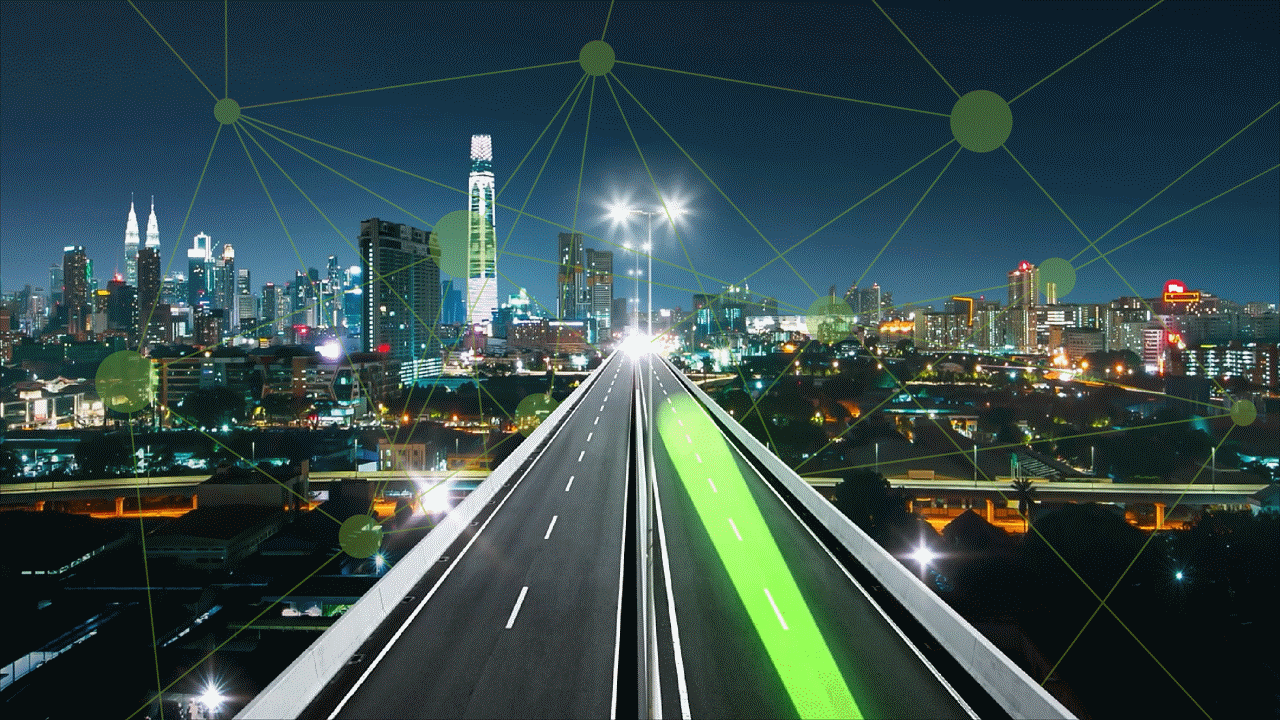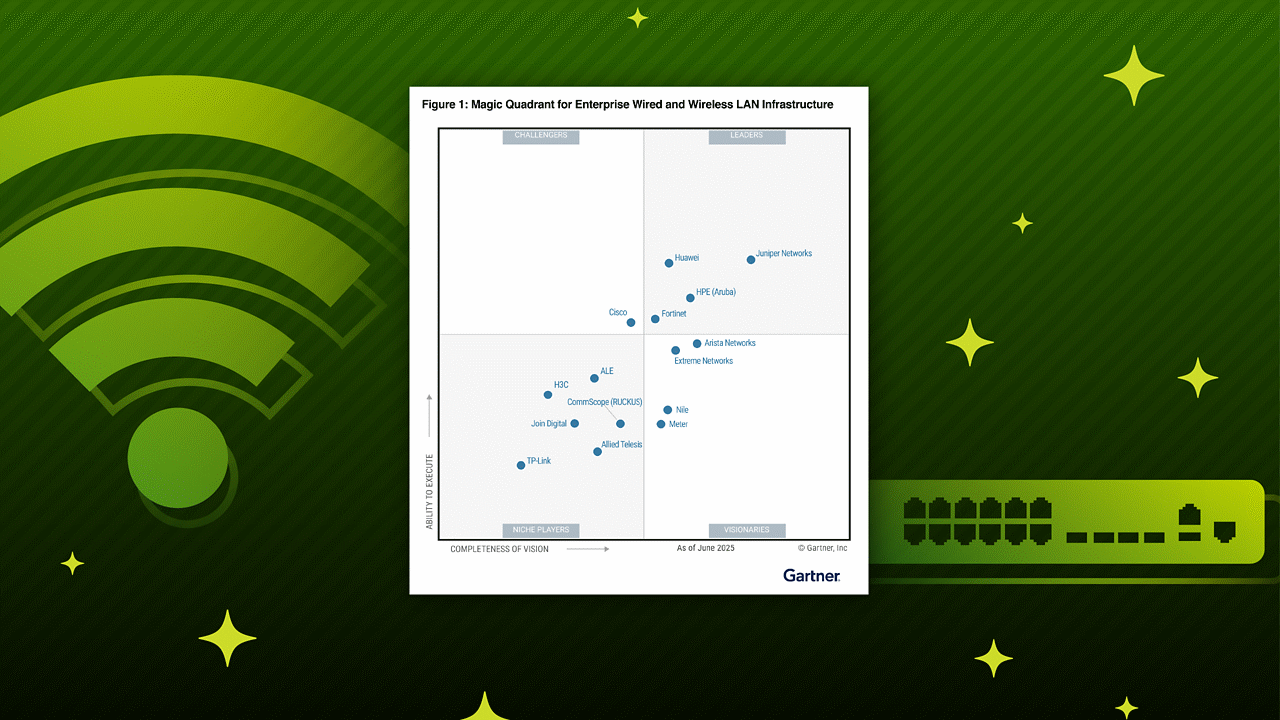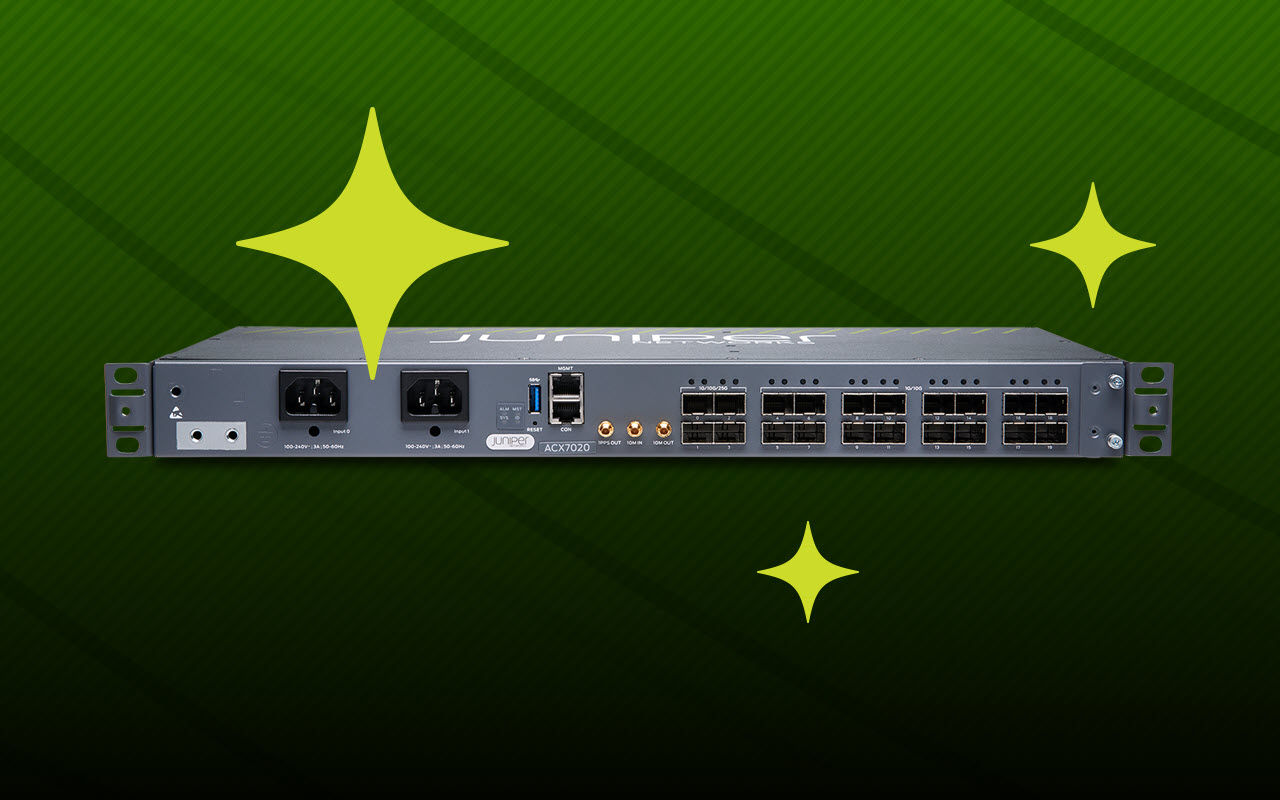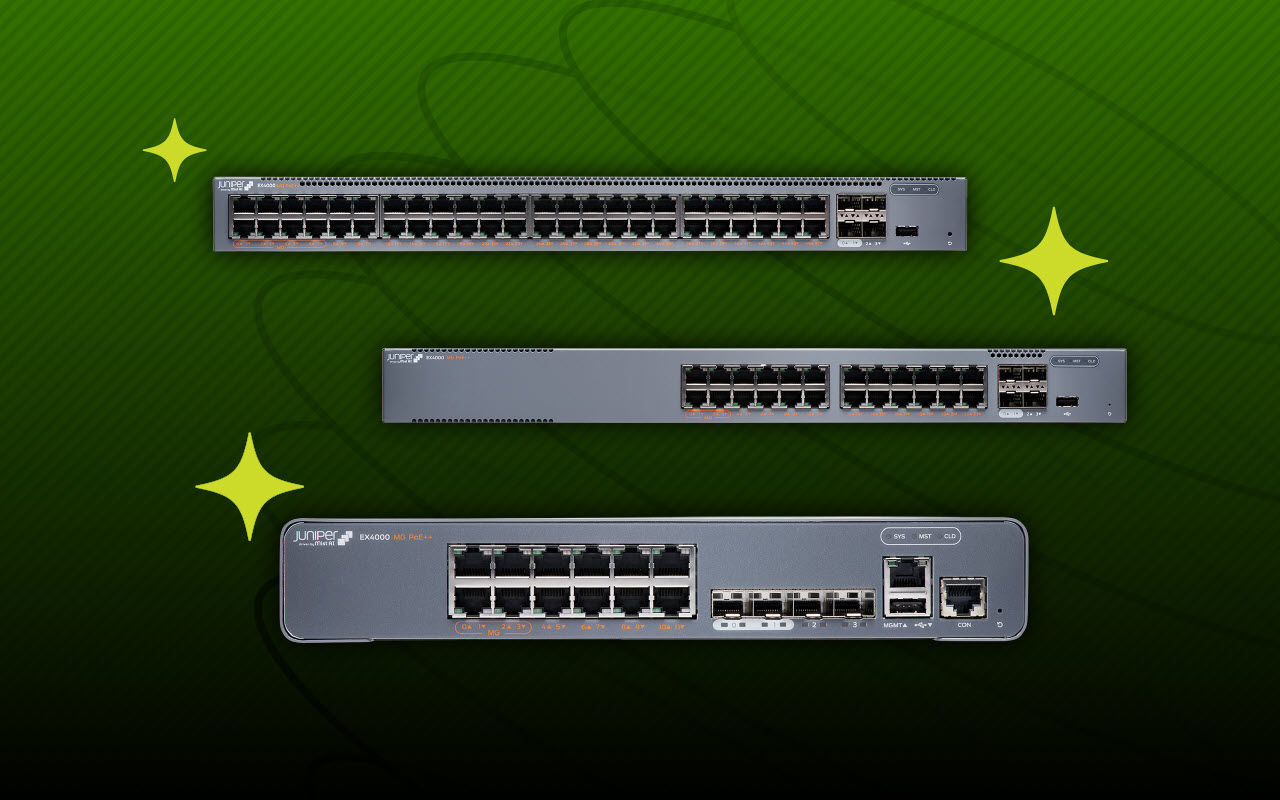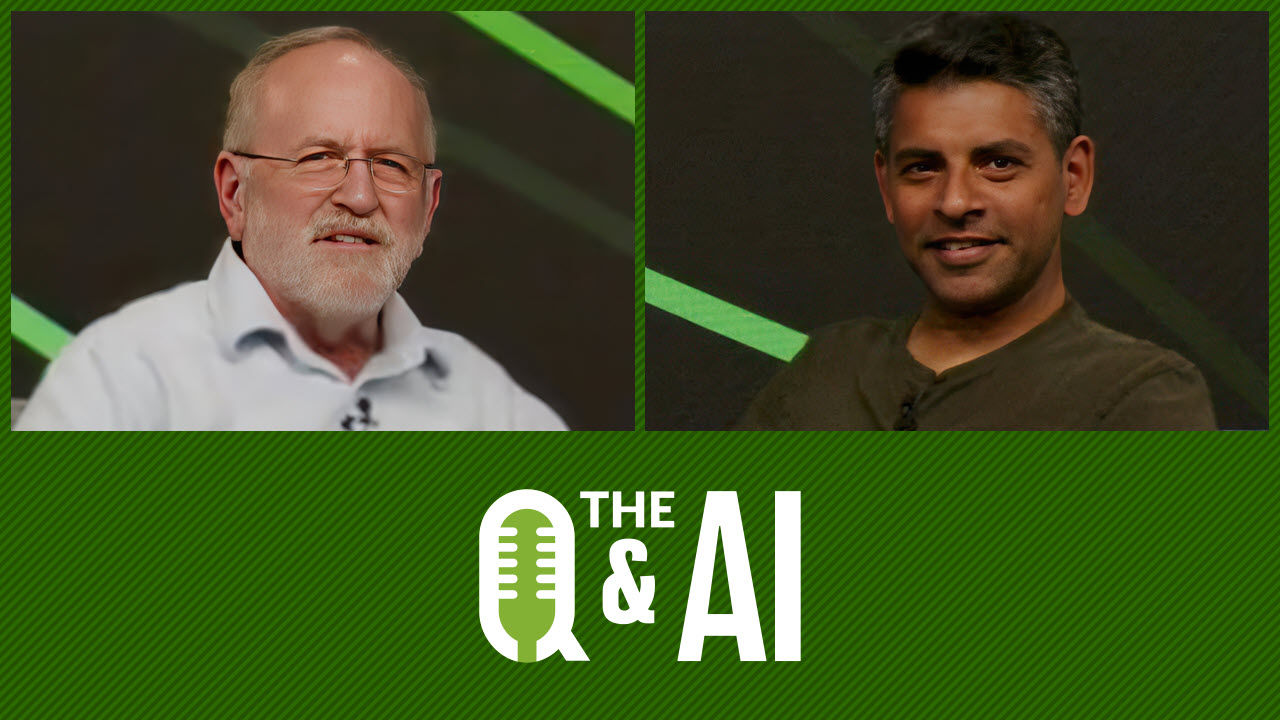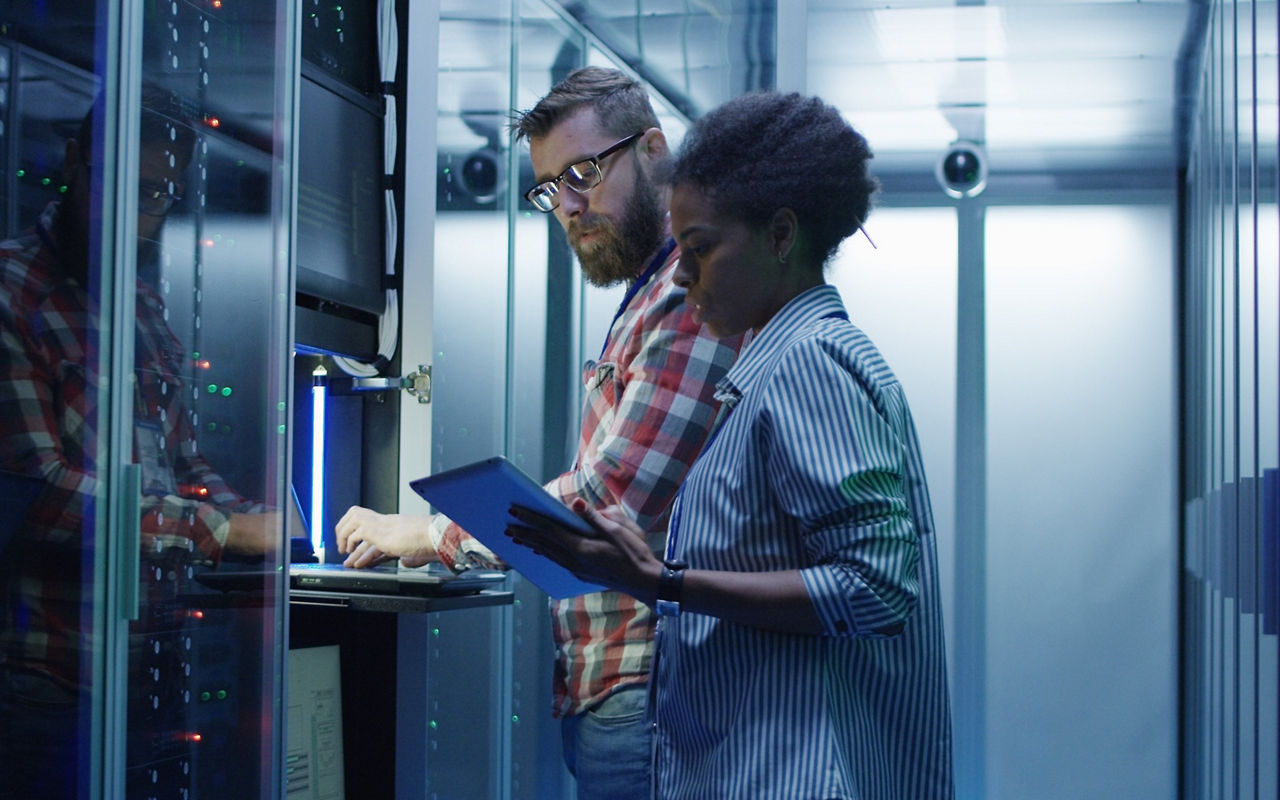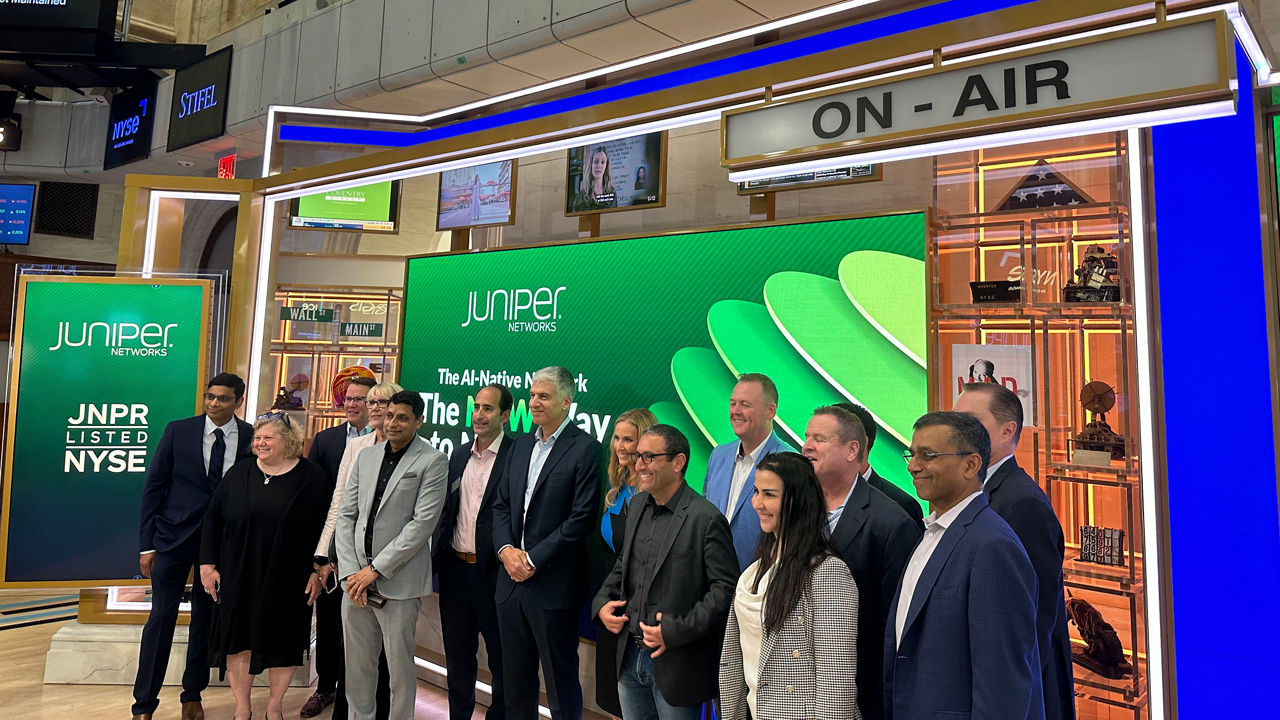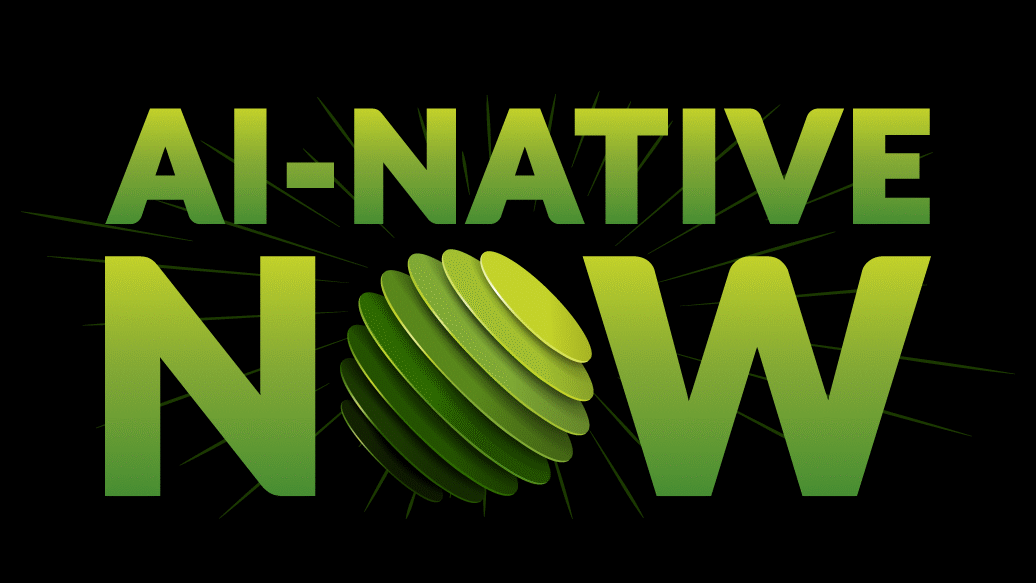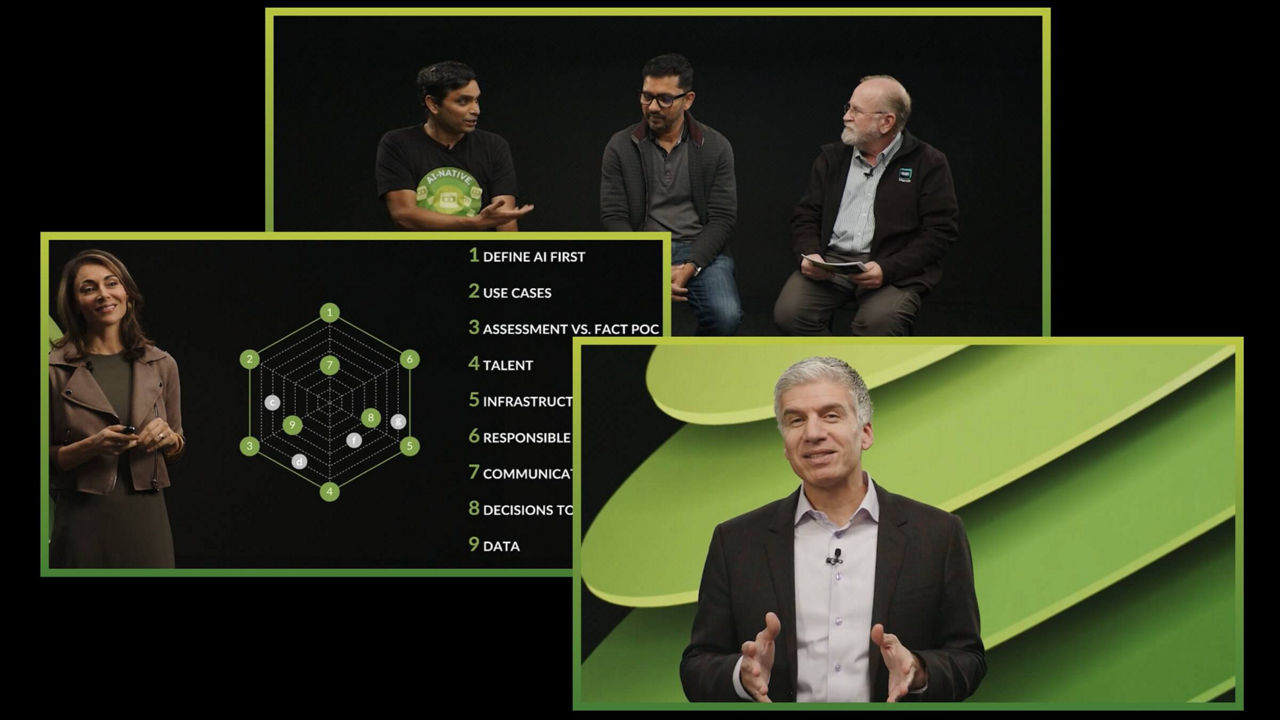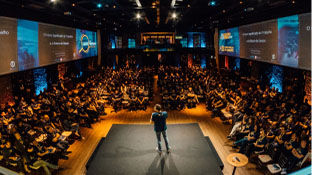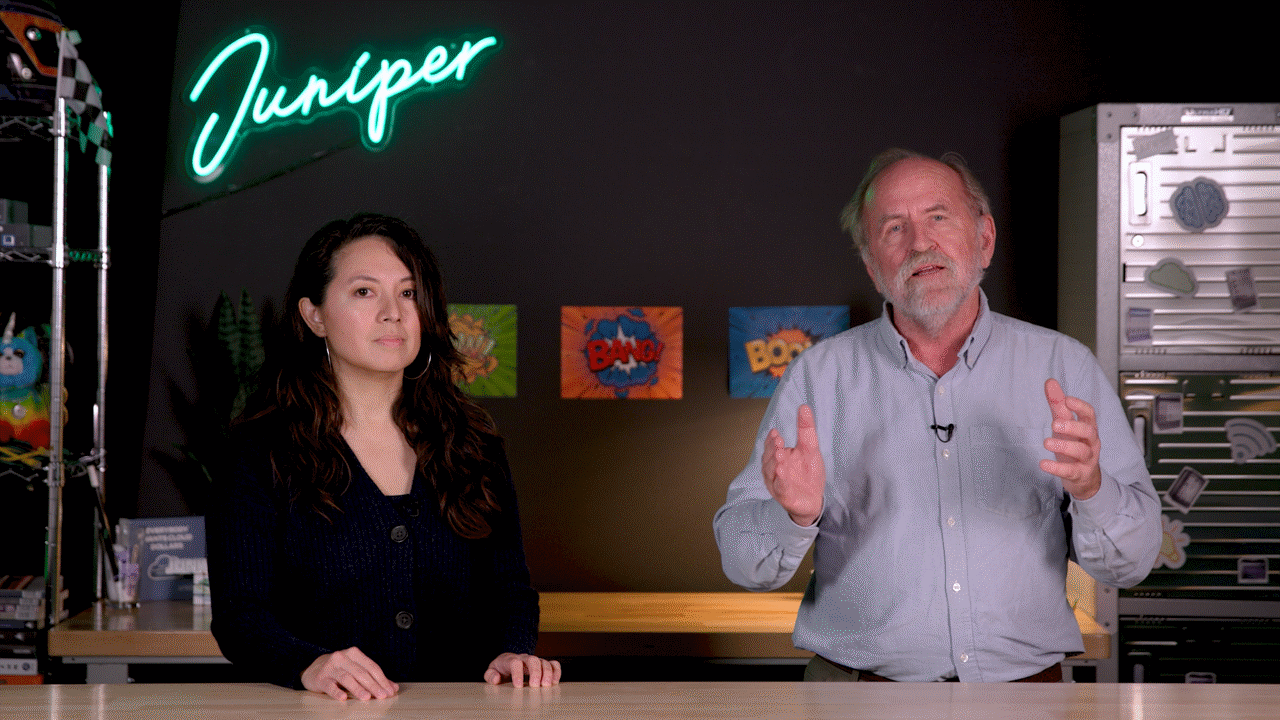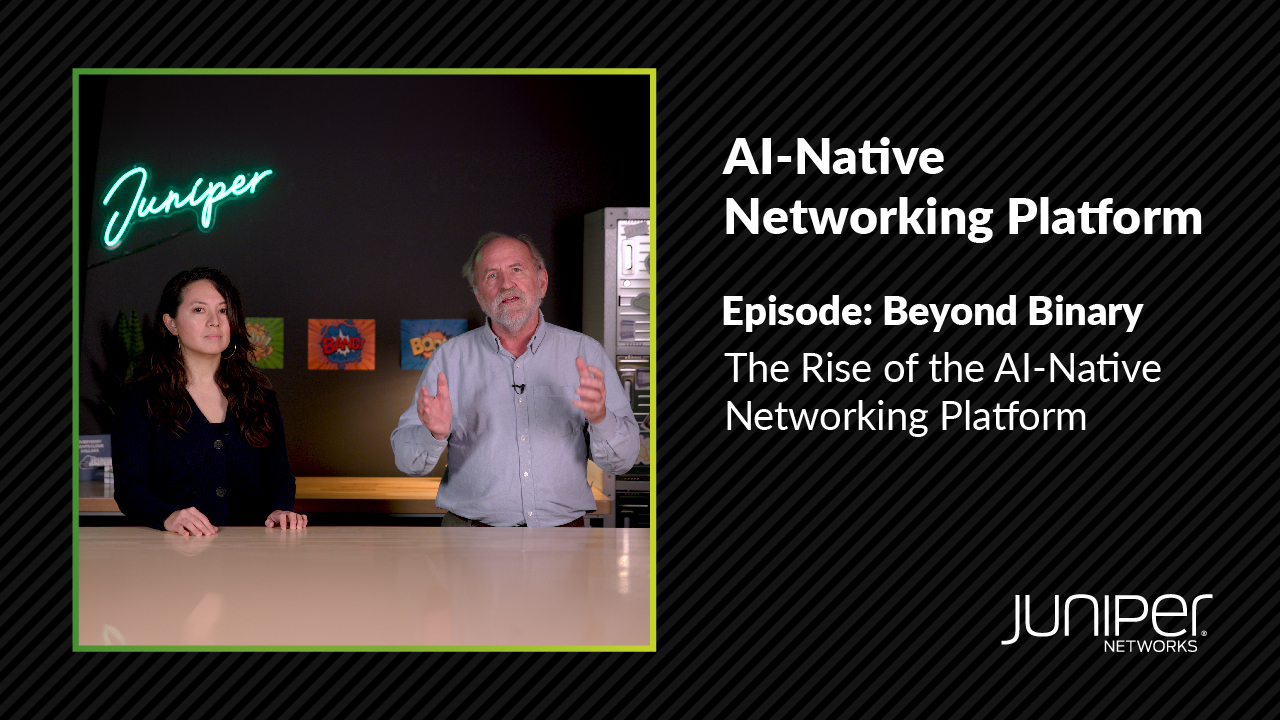AI-Native NOW virtual event


AI-Native NOW virtual event
At AI-Native NOW, industry thought leaders and tech luminaries, Juniper AI experts and specialists, and our most innovative customers from around the planet cut through the AI noise and get down to what really matters — defining, shaping, and being AI-native. Learn how to assure that every connection is reliable, measurable, and secure for every device, user, application, and asset. Experience our AI Data Center, the fastest, most flexible way to deploy high-performing AI training and inference clusters. Explore a range of demos, including a close look at the game-changing capabilities of our virtual assistant Marvis, both in the network and in the data center. And Meet Marvis Minis, the industry’s first and only AI-Native Networking Digital Experience Twin.
You’ll learn
Customers discuss how Juniper helps them achieve increased agility, simplified automation, and the assurance they need for simpler operations, increased productivity, and reliable performance at scale.
Estée Lauder ex-Chief Analytics Officer, Sol Rashidi, teaches us the art of the possible with AI while balancing both risk exposure and maturity levels.
Who is this for?
Host

Guest speakers



Experience More
Transcript
0:00 from making money to Counting losses from enjoying the race to wondering who won from acing the test to waiting to
0:08 reconnect nearly every vital experience starts with a strong network connection but mere connectivity is not the same as
0:15 experiencing a great connection and when you shift Focus from Simply measuring connectivity to the experience of a
0:21 great connection Everything Changes a new vision of networking becomes
0:27 possible we call it AI native networking it's a vision designed specifically for
0:33 AI from the beginning not as a bolt-on or afterthought one that puts the experience first solves the biggest
0:40 challenges for operators elevates every experience for every end user a vision
0:46 that results in up to 90% fewer trouble tickets up to 85% reduction in Opex and
0:52 up to 50% less time to reach incident resolution that means less time spent on
0:57 tactical mundane tasks lower operational costs and more time to focus on what really matters and it all starts with
1:05 the right data the right response the right secure infrastructure delivering
1:10 AI Ops with unparalleled Assurance in a common Cloud across the entire network spanning countless use cases for nearly
1:17 any industry whether leveraging the power of AI for your network or building the optimal Network for AI assure
1:24 exceptional experiences with the AI native networking platform where every connection is reli iable measurable and
1:32 secure we make every connection
1:37 count hello I'm Jean English Chief marketing officer of Juniper Networks
1:43 and welcome to AI native now the AI native virtual event of the year we are
1:50 thrilled to have you join us today whether you're a tech officient Auto and it pro are simply curious about the
1:56 future of networking today promises to show you exactly what AI native networking means for your business we're
2:04 going to Deep dive into the how the what and the why of AI native networking
2:09 including a close firsthand look at real world outcomes achieved by our customers
2:14 like 85% lower Opex 90% fewer trouble tickets and 9x faster deployment times
2:22 during today's event we'll dive into the why the right data the right response and the right infrastructure are all so
2:29 important to optimizing wireless access wired access and sdw domains we'll have
2:36 some great sessions planned where you learned how to ensure that every connection is reliable measurable and
2:42 secure for every device user application and asset you'll get to experience our
2:49 AI data center the fastest most flexible way to deploy High performing AI
2:54 training and inference clusters we'll also explore a range of demos including a close look at the
3:01 gamechanging capabilities of our virtual Network assistant Marvis both in the
3:06 network and in the data center and you'll get to meet Marvis minis the
3:12 industry's first and only AI native networking digital experience twin in
3:18 today's world it's impossible to overstate the impact that AI is having
3:23 across Industries communities and daily life with Gartner estimating that in
3:28 just two years around 80% of Enterprises will have deployed generative AI
3:33 applications in production environments the power and benefits of AI are
3:39 undeniable it's clear that AI is here to stay However amidst the buzz surrounding
3:45 AI it's crucial to discern between genuine Innovation and mere noise at
3:51 jpra networks AI wasn't an afterthought it's at the very core of what we do and
3:57 right now that's more important than ever before because the exponential growth we're seeing with AI is also
4:04 happening with the network by 2028 connected devices are planned to double
4:11 and internet traffic is expected to quadruple with billions of devices and
4:16 users the reliability and efficiency of our networks is crucial users whether
4:22 students in a classroom or nurses in a hospital need an uninterrupted and
4:27 seamless experience that impacts empowers them to thrive in their environments and operators need a
4:33 network that does more for them allowing them to efficiently and effectively manage their Network while predicting
4:40 and solving issues before they ever even knew they exist they need an AI native
4:46 networking approach we've taken a deliberate approach to Pioneer a new era
4:52 of networking Innovation focus on optimizing Ai and unlike others who
4:57 treat AI as a mere add-on we are seamlessly integrating it into the core architecture of our Network today you'll
5:06 get to see firsthand the outcomes of our AI native platform from optimized Network performance to enhanced user
5:14 experiences our Solutions aren't just the mere demands of meeting an AI driven world they're surpassing them setting
5:21 new standards for reliability efficiency Simplicity and scalability throughout this event you'll
5:28 have the privilege of hearing from some of our brightest Minds in the industry including Juniper AI experts Visionary
5:35 customers and esteemed thought leaders all United by a shared passion for
5:41 advancing the world of AI native so without further Ado let's get this
5:46 started please welcome Juniper Network's CEO Ramy
5:52 rahee hello everyone and thank you for joining us today Juniper was born in the
5:58 age of the internet and needless to say we've played a massive role in enabling
6:04 it to become what we all know love and depend on today in fact the internet has become
6:11 the greatest vehicle for Innovation the world has ever seen but we are in the
6:17 middle of an even more seismic technology shift right now and that is
6:23 artificial intelligence which is undoubtedly the biggest Market inflection of our Time For Us in
6:31 networking we're in a once in a generation opportunity to rethink the
6:37 status quo and transform the world's understanding of what a network can be
6:43 to truly disrupt our space and fundamentally change the way we deliver
6:48 value To The World At Large let's consider what our customers
6:54 all of you are up against first users devices and apps are multiplying wildly
7:02 connected devices are supposed to double by 2028 video streaming and sharing is
7:09 rising 30% a year and Global Internet users are expected to hit six billion in
7:16 just three years overall internet traffic is expected to guad ruple by
7:23 2028 additionally digital transformation continues to reshape companies and econ
7:29 economies now it might seem like everything around you is already digital but I assure you there are a ton of
7:36 companies out there that are still doing things in archaic ways and that is
7:41 changing fast digital transformation spending is projected to reach $3.4 trillion across
7:50 the world in just two years which is almost 60% higher than last year and
7:57 don't forget the rise of generative AI in just the last year which represents a
8:04 paradigm shift as the world buzzes around its possibilities Gartner estimates that in
8:10 just two years around 80% of Enterprises will have deployed gen applications in
8:17 production environments meanwhile recent data from the US Department of Labor shows that it
8:25 sector only added 700 jobs in 2023 which is a far cry from the
8:32 267,000 added the prior year you're being asked to do way more with
8:41 less here's the thing the network lies at the center of all of this and none of
8:48 it is slowing down and we need to be more specific here because Legacy best
8:54 effort networking simply won't cut it anymore the network needs needs to not
9:00 only work but to work well because if it doesn't it can mean $35 million in Lost
9:08 revenue for Amazon for just an hour outage in its distribution
9:13 centers one million viewers missing the 100 meter dash if BT's Network goes down
9:19 for just 10 seconds during the Olympics thousands of students miss
9:26 taking a test if a school system like the capella independent school districts Network becomes inaccessible or just
9:34 flaky and at the VA with just 30 seconds of lost visibility patient elopement can
9:41 happen and a patient can wander out the door the issue here is that the focus in
9:49 our industry for too long has remained purely on connectivity performance of devices the
9:56 status of network infrastructure the speed and through of equipment now don't get me wrong those metrics will remain
10:04 an important piece of the puzzle but today Network experiences are
10:09 fundamentally broken and the world needs a new approach to delivering them today
10:15 we still say or at least hear things like I paid for Wi-Fi at my hotel but I
10:21 still can't load new emails my phone has full bars but my zoom call keeps going
10:27 in and out my internet is down but there are no outages reported in my
10:33 area just because someone is connected does not mean they're experiencing a
10:40 great connection this is why our experience first networking strategy is now more
10:47 important than ever when we make that shift from Simply measuring connectivity
10:54 to instead focusing on the experience for end users and for operators
11:00 everything changes for end users it means developers quickly and securely share
11:07 code and project data around the world with confidence Shoppers find what they
11:14 need faster Enterprises rapidly get business applications up and running
11:21 students seamlessly connect with each other anytime anywhere
11:27 instantaneously and for operators experience first means a 90% reduction
11:33 in network trouble tickets at service now 85% fewer truck rolls to Gap Inc
11:40 stores 85% faster network service provisioning for fast host and 50%
11:48 reduction in instant resolution time at Orange Egypt in fact customers small and large
11:56 are experiencing the benefits of our AI I Ops every single day and we care about
12:04 every single one of them because at Juniper every customer is important the
12:10 experience of every connection is important we make every connection
12:16 count to translate this Mission into action we've been busy building an AI
12:22 native networking platform which we just announced in January of this year AI
12:28 native networking isn't just a fancy word a framework or architecture this is a platform that
12:35 will drive experience first networking better than anyone else in the market
12:40 because real proven AI was built into the original product
12:46 architecture these are networks built for AI optimized for AI from the very
12:53 beginning not a bolt-on like some of our competitors think that they can Hawk
12:59 but how do we go about building such a platform we first need to start by
13:05 asking the right experience first questions not questions like is the network up questions like how do we
13:13 ensure every user in every location is getting a consistent
13:18 experience can the network adapt to fix issues before users even know they exist
13:25 Does the network meet the needs of all of its stakeholders our answer to these questions starts
13:32 with having the right technical ingredients first and foremost it's
13:38 about having the industry's only true AI Ops that's capable of running across the
13:43 entire end to end network but not all AI Ops is created
13:49 equal let's get specific about what makes worldclass AI
13:55 Ops it starts with having the right data data because you can't fix what you
14:01 don't know needs fixing and fortunately we had the unique foresight years ago to
14:07 build products in a way that makes it possible to extract Rich network data
14:13 from them so now we're collecting mountains of the right data from
14:18 switches and access points with routers and firewalls not far behind that allow
14:24 Network operators to understand what end users are experiencing
14:30 ing of course it's not enough just to collect the right data it's also about
14:37 what you do with it the response must be timely and go beyond flashing alarms by
14:44 understanding the satisfaction of every user on the network at all times we
14:50 solve problems for customers before they ever realize there's an issue bad AI Ops
14:57 gives you flash flashing lights and alarms often false ones the it administrators eventually just
15:04 ignore good AI Ops Juniper's AI Ops is about proactively fixing issues before
15:12 they start affecting the experience and lastly none of this is
15:18 possible without the right secure infrastructure Juniper has the
15:24 industry's most scalable infrastructure for the AI era from devices to operating
15:30 systems to Cloud hardware and software it's infrastructure that's built to
15:36 process massive amounts of data and importantly achieve gamechanging
15:41 outcomes with it so real AI depends on three ingredients it must have these
15:49 three ingredients the right data the right response and the right
15:55 infrastructure if you're missing any of these you are out of luck you just can't
16:02 take an existing on-prem solution throw it in the cloud and expect results anywhere close to what we can achieve
16:10 with the right data the right response and the right infrastructure built from
16:15 the start we've proven the efficacy of our
16:21 aops in the campus and Branch but to us aiops can and will be way more than that
16:30 if an application is having issues a zoom video gets jittery or a cell connection keeps dropping it teams get
16:37 blasted with trouble tickets from end users that often say the app isn't
16:42 working or the Wi-Fi is bad it can be like finding a needle in a Hast stack to
16:49 troubleshoot and fix incidents like these the kind of problems the effect
16:55 end user experience can reside anywhere through the network or even in the application itself a software issue in
17:03 the data center a configuration problem in a core router a bad cable
17:08 somewhere this is precisely why our intent is to expand our AI Ops from the
17:15 end user all the way to the application and across every Network domain
17:21 including campus and Branch Data Center and wide area networking because I imagine the world
17:30 where there simply are no more Network trouble tickets anywhere no application
17:36 downtime or performance issues no network outages no one even knows that
17:42 there is a network operating behind the scenes there isn't a single human
17:47 touching the controls of the infrastructure in fact there are no controls or UI at all there's no need
17:53 because everything just works and works well across every every single
18:00 domain this is a vision we set out to achieve years ago and we've been making
18:06 real progress in the last several years we now have all the pieces in
18:13 place with our AI native networking platform to bring it all together and fully realize our vision in fact I
18:21 believe that in the very near future we'll be able to guarantee that organizations leveraging our AI native
18:28 networking platform will see at least 90% less Network trouble tickets after
18:34 deploying a juniper solution that they'll speed up their deployments by
18:39 nine times that their network will see five nines of assured up time with
18:45 juniper AI working its magic in the background this is what we are working
18:51 toward and in just a short bit you're going to hear from our technical leaders
18:56 exactly how we are differ differentiating with AI not only with exciting new product updates in the
19:03 nextg campus and Branch where mist has already shined for years but also in
19:09 modernizing the data center to satisfy new AI workload specific
19:15 requirements I believe AI is the biggest Market inflection since the internet
19:22 itself and having already seen revenue from missed AI powered products grow
19:27 nearly 70% year-over-year from 2022 to 2023 I
19:34 have the utmost confidence that as we extend AI Ops throughout all layers of
19:40 the network with our AI native networking platform we will continue
19:45 delivering gamechanging value to our customers it should be clear by now the
19:53 AI isn't an embellishment for us it's the backbone of how we envision the
19:59 future thank you very much thank you Ramy so how can Juniper's
20:07 AI native platform transform your business our next speakers who have been
20:13 leading this AI Revolution and networking for many years we'll show you how using the power of AI can
20:20 dramatically reduce trouble tickets and lower operational cost please welcome
20:25 Bob Friday group vice president and our Chief AI officer along with Sadir mat
20:31 group vice president of our campus and Branch Solutions Bob and Sadir will also be joined by some of our Visionary
20:38 customers who will tell you how junipers AI native Solutions are fundamentally changing the experience of those who
20:45 operate their networks and those who use them hello everyone I am so excited that
20:52 you could join us today Sadir and I are here to talk about AI native networking
20:57 and and how it's fundamentally transforming Enterprise networking in a world where mobile internet connectivity
21:04 is becoming a musthave in our business critical applications mobile internet connectivity is becoming a necessity in
21:11 keeping us connected to our customers our partners our Associates and most critically to the business applications
21:18 that are running in the cloud nowadays you know for me personally this journey started when I was at Cisco when I was
21:25 working for some very large retail customers and I was trying to sell them a connected mobile experience in their
21:31 stores and what they told me was Bob before we put anything on this network
21:36 you have to assure me your controllers are going to stop crashing you really have to innovate faster I need more more
21:43 updates more than once a year and more importantly they told me they weren't going to put anything on that customer
21:50 phone until they were ensured they're going to have a great experience that is when I realized that there was a
21:55 fundamental Paradigm Shift where we're moving moving from helping Enterprise manage Network elements to one of
22:01 helping Enterprises manage the user to Cloud experience and so that's when we
22:07 realized that the journey needed a blank sheet of paper we looked at it and said either we're going to do this in a big
22:13 company or is this a problem an architectural change that required a blank sheet of paper and what we
22:18 realized it was going to be easier to solve this problem from scratch and T with a blank sheet of paper to really
22:25 build a cloud-based solution that can handle data in real time and secondly as
22:31 we went down this journey we started with the data right people always ask me why did you build an access point it's
22:37 not like the industry needed a new one it was more about making sure we could get the data we needed to answer the
22:43 question of why you having an internet connectivity problem and I will tell you when we started that Journey it probably
22:49 took a year to get the right data out of the aps the switches and the routers right because what we found in addition
22:55 to building this Cloud architecture we really need to organizationally take the data science team and the customer
23:02 support team and join them to the hip and that was the other part of the journey is making sure you can actually
23:09 take your customer support team that is really a proxy for all our customers and make them happy and so I tell people if
23:16 your vendor is not using their own cloud AI op solution support team they have not really started the journey the other
23:23 critical step in this journey was really around the user interface and continue
23:28 language natural language models now I firmly believe that we're seeing the user interface migrate from the CIS to
23:36 dashboards and the next user interface is going to be around chat gbt and natural language and interacting with
23:42 your network and getting data about and that all leads to the beginnings of a South driving Network that actually can
23:48 take actions on par with a domain specific it team the other part of the question people ask me is about AI
23:55 marketing white Wars reality and what what I tell people is AI is really just the automation the next step in the
24:02 evolution of automation right if you look what we've done in the past we've always built
24:07 solutions that basically like the car Robot did the same repetitive action every day day in networking we wrote
24:14 scripts that basically were very repeatable now we're actually Building Solutions that are doing cognitive
24:20 reasoning skills on par with domain expert human right we're building solutions that can really do those
24:28 problems that you typically need a human to solve and usually I break AI into two buckets we have kind of the machine
24:34 learning algorithms that we've been using over all the last 30 40 50 years what's really disrupting the industry
24:41 right now is really around these deep learning models this is what makes chat
24:46 GPT so exciting they're now building Transformer models 175 billion
24:52 parameters you know that are large and they're build solving problems that look like a real human
24:58 right and we are now doing the same thing in the networking space we are now building models where we take Zoom teams
25:05 data we're joining that with network features and we have millions terabytes
25:10 of data to Now train models to accurately predict your zoom and team's
25:17 experience and once you have these models built we can now use techniques like shapley that can now start to
25:24 explain why a user is having a problem we recently had a very large customer
25:29 who has a problem of zoom in one of their facilities in India been working on it for 3 months or so could not
25:35 figure out what was going on once we brought this model to bear on it within
25:40 half a day hours or minutes it was easy to become obvious that really the VPN distance was the problem they had
25:47 misconfigured a VPN Gateway so they were now routing packets from India to Australia looping the back they weren't
25:54 doing it for everyone and that's what we call the needle and the Hast stack problem and and this is where Native AI
25:59 native networking is really going to transform it departments the future and really helping them solve those tough
26:05 problems that humans can solve but may take months or years to solve so with that I'm going to hand it over to Sadir
26:11 who's going to go over some of the latest Innovations at Juniper here and what some of our customers are doing
26:17 with it Bob thank you and thank you everyone for being part of the AI native
26:23 now event from Juniper Networks we have had some amazing customer in retail in healthcare in education in
26:31 corporate Enterprise in K12 in so many verticals we have had full stack wins in
26:38 Wireless switching STD van and Knack where we're delivering amazing user it
26:46 and business outcomes for you our customers and partners rather than me
26:51 explaining how we are transforming it and user experiences I want to bring on Neil Collins from mus grave the largest
26:59 retailer in Ireland who I recently interviewed for today's virtual event from mosg Grave's perspective and in
27:05 particular for our superv value and Centra Brands right we had old Legacy technology so about three years ago we
27:13 engaged with juniper we went through a tender process and the outcome of that now is we have a generational jump in
27:21 our Network Technology in our stores in the old world if we were upgrading our Network in a store four teams would go
27:28 in right it would be two out of hours visits and one possibly two daytime
27:33 visits in the new world it's one visit and it's one engineer right so from a retailer point of view you're talking
27:40 about three disruptions to the store to the m of ours to no disruption to a store we can replace the network in
27:47 under one minute outage time in all our stores and we're on that road now from a
27:52 from a roll out perspective we piloted in 15 stores so we we we really were
27:57 home owned in on our processes and in particular this ear touch deployment process and for that it was all about
28:03 the router and the switch so we on our cellular network we bring up the the router deploy the switch and then it's
28:11 we're only switching for that 30 seconds we're only then moving to the new Juniper router but all of the config is
28:18 all in missed so we have everything automated it the engineer he can
28:23 download the config he can get it operational in in seconds really with the pilot stores the focus is all all
28:28 about our customer the retailer they're very much cost focused cuz it's uh it's
28:34 retail and the real benefit is they're not paying for people out of hours they're not paying for Network Engineers
28:40 they're not paying for M grave to come in and do stuff as I say it's one engineer one visit and we're we're
28:46 done did you hear him say one engineer one minute downtime in one visit to
28:53 transform their legacy Network wired wirel less and Van to the modern Juniper
29:00 Network that's AI native and Cloud native this is the kind of outcomes we
29:05 can drive for our customers like you now let me introduce you to the
29:12 future of AI in networking with our recent product announcement of Marvis
29:18 minis never in the history of networking has anyone gone where we are taking AI
29:26 but let's first look at how how Marvis finds problems today today every user in
29:32 every single AI application including today's Marvis a user has to be on the
29:38 network and has to experience failure for the AI model to be able to either learn on it or make assertions based on
29:46 whether this is a systemic problem or an isolated problem so user has to suffer
29:52 before AI can make an assertion but what happens when users aren't on the network
29:57 how do you make sure they get an amazing experience when they come back and connect on the network this is where
30:04 Marvis minis comes in to bring a more predictive proactive insight and
30:10 Remediation for your networks with Marvis minis this is a real digital
30:16 experience twin in the network natively built in when we say AI native
30:22 networking what we mean is our AI is natively embedded into our bloodstream
30:28 at this point so for wireless for switching for SD van we're actually able
30:33 to send Marvy Min out there before users experience failure before users come
30:39 onto the campus Network and be able to look at how the network is performing literally Marvis can send minis out
30:46 there let them validate the network and be able to predict and most importantly be
30:52 proactive this is what every CIO wants to be proactive before or users
30:58 experience failure so far every AI model that is out there is happening after the
31:03 fact we are the first ones to validate the network experience before a single
31:09 user connects I can tell you if your vlans are missing if you have a radio server
31:15 that's unreachable a DHCP scope that is run out of Ip space a DNS server that's
31:21 unreachable an application that's unreachable all of it with Marvis minis right now customers are bombarded with
31:29 problems like scope run over like a misconfiguration causing issues long periods of validation for deployments
31:36 blast radius determination when a user has an issue the impact of Marv minis is
31:41 far reaching we're just scratching the surface now let me give you a couple of real customer examples where we've
31:49 already deployed minis in production ashin Public Schools beautiful uh School
31:54 District in the state of Oregon Steve Mitchell and Shahid have deployed this
31:59 and have been testing this over the last quarter absolutely awesome to be
32:05 proactive to students before they go for an exam before teachers have to onboard the students onto the classroom they've
32:11 been able to remediate problems before student experienced failure a similar story much larger deployment University
32:18 of Washington EML Caldwell and her his team as they're rolling out the Juniper
32:23 M Network in new buildings as the new buildings are coming on with the jip Miss Network they've been able to use
32:29 Marvis minis to find problems proactively an example was a missing Wheeland that was not configured on a
32:36 switch ML and team found that out before students came onto the University campus
32:42 this is the power of Marvis minis with Marvis minis by the way there is no
32:48 button to turn on literally there is no configuration this is a self-driving
32:55 digital twin experience first in the industry it's natively built into the
33:00 network by Design This is AI native networking Marvis minis will learn the
33:08 ssids you have it will learn the VLS that are connected to those ssids it
33:13 will learn the DNS servers that you're using the DHCP servers you're using it will learn the applications that are in
33:21 use at every site every time completely natively it will learn and then start to
33:28 validate it so not a single nerd knob to connect and turn on literally deploy
33:33 Juniper Mist APS and minis are at work this is the power of the digital
33:39 experience twin of the user in the network it can't get easier than this
33:46 this is AI native
33:51 networking Bob and I had an opportunity to sit down with a few of our customers to hear hear from them how AI native
33:59 networking is making every connection count let's take a
34:06 look hello everybody and welcome we are excited to having hosting two of our
34:12 best and brightest customers John Zander from George Washington University and
34:17 saiv nyer from service now we have a great conversation to we had tremendous networks they've deployed with junip
34:24 pist Bob why don't you kick us off see thanks you know John you've been with us for about 2 and a half years on the AI
34:30 native networking journey and I think you've been with us for 6 years almost so I thought maybe we could start with
34:35 sharing with the audience you know how that Journey started with you and kind of broad Strokes on what were the
34:40 outcomes you've seen on this journey well so in higher education we
34:46 don't necessarily always have a lot of resources and what we've been trying to do over the last few years is really
34:51 standardize simplify and automate our Network give our Engineers a chance to engineer and get away from the
34:56 day-to-day operations so that was really the Catalyst behind us looking to make a change and Juniper was one of the
35:03 products that we looked at we looked at all the industry leaders we did a proof of concept with you guys and during that
35:11 proof of concept we were able to see the value of being able to picture the
35:16 network have a tool set that would compile all of the information we needed in one location analyze that for us and
35:23 give us real-time feedback on what we were looking for and after that it was a matter of just transitioning an
35:30 enormously sized Network and higher education and it couldn't have gone smoother we have over 6,800 access
35:37 points spread across three campuses 160 buildings we managed to get that all
35:42 replaced in just over three months to give you some context the last
35:49 time we did half of the aps on campus took two years wow so this was a
35:54 tremendous kind of Daisy zero to day one integration with our systems that went
36:00 extraordinarily well and we could have been more pleased with it well thank you and S maybe your viewpoint on you know
36:06 you've been on the journey a little bit longer yeah I think uh for us uh it was 2018 when we were you know kind of you
36:15 know changing the direction of the company for you know much higher Pace growth and the complete Focus was around
36:23 you know how do we simplify things and set ourself for that scale right and uh
36:28 you know user productivity user experience was one of those top drivers
36:33 that we identified at that point of time and anyone that we interacted at that at that moment that in that era we were
36:40 always looking for that that commonality in that thinking and the DNA right and I
36:45 think that was uh the year when we met the M team and one thing that resonated
36:51 super well with us is that you know for them the the simplification The
36:57 Experience driven networking those are all some of the things that that completely you know sat well with us and
37:04 we decided that you know we should we should basically embark on this journey with mix Mist in the mix and um I think
37:12 that's how it all started and uh we've come a long way and uh I have some amazing stories that I will share as we
37:18 as we go along here awesome thank you saiv and so John for a lot of the customers watching you know they are
37:25 today running Legacy controller based architectures which you have run yourself as well and so compare and
37:32 contrast you know the day in the life of running the Legacy Network and and and
37:37 now the Juniper Miss Network sort of what is your team seeing differently and you know the for the customers listening
37:44 why should they consider this transition so it's it's a very good question because it doesn't always come
37:51 off as obvious when you talk about just the controller versus the AI driven platform but but in our experience so
37:59 far with mist we've actually seen an incredible reduction in the number of day-to-day tickets that we're seeing our
38:05 day-to-day operations from an engineering perspective are exactly that we are looking for the next thing that
38:11 we can do with wireless to provide for the student experience we're no longer kind of chasing our Tails trying to
38:17 figure out which element of the network is having an issue uh we've seen anywhere in a month-to-month comparison
38:24 between last year and this year a 40 to 70% reduction in tickets and that's
38:30 tickets as a whole for wireless that's not just tickets that are escalated to my senior engineering team those are
38:35 even fewer we've also found that even with network elements that are not a part of mist uh I'll give you an example
38:43 we had an issue with uh one of our authentication servers falling out of sync with the cluster earlier this year
38:50 and typically that would cause an investigation where we'd have to troubleshoot multiple aspects of the
38:55 network narrow it down identify the issue in this instance Marvis was able to point us in that direction to the
39:02 specific server in that cluster by telling us that there was a 275%
39:07 increase in errors on that authentication server I mean the time to
39:13 resolution on that was night and day between what it would have been and what it is today that was probably the
39:19 biggest experience we've had so far and how this can really impact our ability
39:24 to keep everything up stable and working for our students yeah you know John that's a great story you know I always
39:30 tell people like AI is what's really helping it teams find these needle and the Hast stack problems now you know so
39:35 D now maybe back over to you a little bit you know we started this journey with wireless access points because we were trying to answer the question of
39:41 why you're having a poor internet experience you know since joining Juniper we're starting to extend Marvis across the switch and the router maybe
39:49 you can share with the audience a little bit what you've seen on the journey in solving problems and the outcomes you've
39:54 seen inside your services team as we extended across the stack yeah yeah it's
39:59 a it's a great question and I think there is a a phenomenal amount of learning that we have gained through the
40:05 transition I think it was during covid and we had this opportunity to make some bold decisions and I think as a as a
40:13 company when people were all working from home you know some of the decisions were like were were required to be taken
40:20 because the world was changing and we some we we and our journey that was started in 2018 with with user
40:26 experience with Simplicity of our architecture um the scale that we wanted
40:31 I think our thinking was very much in that direction and we made this decision that you know we want to be you know uh
40:38 you know environmentally uh friendly in when it comes to network people don't
40:43 think about it much but uh you know there is there are some very fine elements that that actually defines that
40:49 and then there is uh the people were working from home and they were ready to come back to office whenever covid uh
40:55 you know change uh you know things um and we said okay you know do we really
41:01 need uh you know this dense Network and can we simplify it and go Go Wireless um
41:08 completely and and then only keep the iots on on on wired so as we started thinking about it we were also thinking
41:14 that how do we scale this whole approach with a common road map common mindset
41:23 and I think the the answer was you know we wanted to kind of extend this journey and you know continue this journey with
41:29 a partner that had this going across the board so you know we we didn't have to
41:34 look too far you know Juniper um Miss combination was you know going Beyond
41:40 Wireless to Wi to when so we decided to kind of go single stack and go you know
41:46 U the the the switching infrastructure over to jenniper and then the uh and the and the SD van over to SSRS so that's
41:54 how you know we transition and I think the the biggest learning that we have got out of it is that the capabilities
41:59 of Marvis and the AI that was limited to Wireless at one point is now extended
42:05 across the board and um it is uh something that I'm going to you know steal from Juniper's book which is that
42:12 we said okay you know what this client to Cloud journey is looking like a reality now because I can see things end
42:19 to end this was not possible before and and saiv honestly speaking thank you very much for being a partner driving us
42:26 towards this and most recently you've added one more part of the portfolio uh
42:32 which you haven't deployed yet but you've tried which is Knack uh so talk about sort of how Knack came into the
42:37 picture yeah so um you know as uh as we are transitioning simplifying things uh
42:45 we we have a a legacy Knack system that is I can sort of sort of say that it is
42:50 an on Prem system and being a SAS company and very SAS friendly you know we we want to kind of make things pretty
42:57 lightweight for us and um in one of the products strategy Summits the idea of uh
43:04 a SAS Knack offering was was kind of uh you know socialized and we were like
43:11 super excited when we heard about that so we are now getting very close to uh
43:16 adopting the The Knack solution that um you know Juniper Miss team has has come
43:22 up with and we're looking forward to the to the benefit and the scale that it will deliver in you know comparison to
43:29 um what we are not able to achieve today awesome thank you so John um you've summarized for us uh the three things
43:37 that I always tell you know uh first of all as as much as sajiv is here highered
43:43 is probably the hardest networks to run because your network is changing on you
43:48 every three months kids are coming in with new applications new devices all the time and so the three outcomes I
43:54 always you know promise High customers is faster deployment fewer tickets and
43:59 fastest meantime to resolution and you've already hit on all three of them at a broad Strokes level anything else
44:06 that your team has seen in terms of Automation in terms of integration with other systems any other benefits people
44:12 should think of as they consider J prist yeah I mean we've uh we've been
44:18 looking for a while we we call it we want to provide the at home experience for students and one thing that we've
44:25 never had the resource to be able to do is to kind of look into the private pre-shared key networking and that's
44:31 something that we're currently piloting in one of our dormitories for our students and we view it as something
44:37 that go beyond just a student experience we are a research institution we have
44:42 various use cases in the classrooms where this could be applicable and this is something that we're very excited to
44:48 finally be able to do and Juniper has given us the tool set to be able to do that and much quicker than we thought we
44:55 were able ble to because of how well things have gone with our deployment of junest awesome thank you John and for
45:02 everybody for all the audience listening my closing statement with with most of our customers when we first meet
45:08 them and I said this to John and saiv as well is we're not a vendor to you we're a partner to you we want you to feel
45:14 like we're an extension of your team John I want to thank your team in in helping us build this you know atome
45:21 experience for a student in the dorm uh dorm room we're so close to actually
45:26 launching that in a big way and you know blending policy across uh pre-shared key And1 xss IDs with our Knack solution now
45:34 ready for edu roam all kinds of interesting things are possible so we're stoked one thing that everybody
45:40 listening you've heard just just in the previous session is this brand new announcement around Marvis minis Marvis
45:48 minis is is our ability to be proactive to the network you've heard me over and over talk about the impact it can have
45:55 and one thing we've partnered with our customers to to do is to build Marvis Minis and we asserted to ourselves we
46:02 are not going to launch it until we tested with production customers and so s sajiv thank you for uh you know
46:09 helping us build and partner with Marvis minis what is your thoughts on the impact Marvis Min can have and what has
46:15 your team seen you know this is uh uh something that we've been waiting for for for a long time U was another great
46:23 idea that was socialized during one of those strategic conversations and uh for us uh you know when we think about the
46:31 capabilities that you know the junipers and Mist stack brings together the zero
46:38 touch provisioning was one of the big things that helped us you know go through this whole network
46:44 transformation during the covid era zero travel no people to go and deploy stuff
46:49 or they were like very limited people so I think in my mind if I if I kind of think about it you know uh we solve the
46:56 deployment side of zero touch but when it comes to the changes and the post change testing there was no ability for
47:03 zero touch we needed users or people to go into the offices and do the testing I think that's where I see Maris Marvis
47:11 minis is kind of doubling down on that zero touch concept into the end user
47:17 area right it is it is giving us the ability to do um you know self-initiated
47:24 test post changes we can do continuous experience monitoring uh we are pro
47:30 potentially also looking at consolidating some synthetic monitoring tools here because we can go and in you
47:37 know introduce new uh service URLs that uh that is a great capability and I'm
47:43 super excited and we are we're just getting started with this and I think uh this whole uh you know whole narrative
47:49 around experience is going to just just get immense boost uh with milk Minis
47:55 awesome thank you Bob go ahead you know and S I want s I want to thank you because you know in addition to being just a great customer you've been truly
48:02 a great partner right marvelous minis is a great example where it actually started with our user Community right
48:07 it's been one of the most requested items for how many years to year it took us a while to build it but we're here now but you know so D maybe we can also
48:14 share with the audience the other big transition is really going from this Legacy controller architecture to This
48:20 Cloud AI office architecture I thought maybe you could share with them any best practices potholes you know what was
48:26 that transition like you know in helping the team go from kind of this SSH CLI
48:31 world into this Cloud I Ops you know we're not we're not sshing into these devices anymore as we connect them to
48:37 the cloud I I always say that you know uh there is uh there is Technologies and
48:42 tooling out there and and but that alone doesn't get you where you need to go you need to make some bold decisions as a as
48:49 an IT leader or a or a or a it group that is uh wanting to you know Drive the
48:55 the digital transformation uh we preach as service now about a lot about digital
49:01 transformation so it has to kind of start within right so for us it was like a combination of bold decisions okay we
49:07 need to we need to kind of get get down to a place where uh this is you know this is not the normal this is this is
49:15 this is the future right we want something that will scale with us we don't want to be building things uh you
49:22 know as we were growing you know it should just scale by with it with with with the with the growth that we have so
49:27 I think in in in terms of the learnings I would say uh Marvis and Mist uh offers
49:34 a lot of tool tools uh in the form of you know AP placement tools you have uh
49:39 you know the we talked about the the minion there are there are a bunch of other things that you can like zero
49:46 touch uh and and and I think John you mentioned about the the prad key so we just rolled it out for our mobile users
49:54 and that's a major hit because it it completely uh took the key in the password equation out of the mix right
50:00 so so big win and if if there is if there are anyone who's in the audience
50:06 you know service now customer if you're not one you know you should become one soon but I'm saying that there is a
50:12 there is a phenomenal amount of Integrations that we have built Marvis actions are now able to communicate
50:18 directly with the service now platform through the integration we're also uh able to do Global uh like a
50:26 you can upgrade the firmware on your Fleet no matter where it is uh is with a single change order ticket so these are
50:33 some of the innovations that we have been able to work in partnership with jenniper not just taking what they have
50:39 to offer but also bringing our platform into the mix and and kind of just uh putting this whole thing on steroids
50:46 thank you sajiv because I think for service now customers who are listening in uh a lot of what sajiv is talking
50:51 about is is available on the platform and and sajiv and team have been uh very forthcoming in sharing their best
50:57 practices as well so as we wind this down John I think the the biggest hurdle
51:03 for our customers is taking the first step so what would you advise uh because
51:08 you know the the what they're thinking is wow this all sounds great this is where is the future I want to get to but
51:16 I have a big Legacy system uh my my team is trained on it my team is you know we
51:21 spent all this time perfecting the art of it what is your advice for customers
51:27 uh um as to how to get started absolutely I mean that's definitely the most difficult step to
51:33 take and I think knowing that this product can stand on its own through an
51:39 evaluation we ran a fairly vigorous proof of concept with this platform and
51:44 others and I would recommend if you had the capability to choose an area highly
51:50 trafficked at your University run a proof of concept see the difference that it can make and use
51:56 that as justification to move forward with it we had no doubts once we were done the proof of concept the direction
52:03 we wanted to head and the benefits that it would provide to our faculty staff students our entire
52:08 Community awesome uh saiv any words of wisdom uh as we close this no I think I think John captured one one important
52:15 point which is you know go for the proof of concept proof of value establish that
52:20 and then um you know and look at this whole thing pretty comprehensively right uh AI is here to stay if you're not in
52:27 the in the game in the business of you know dealing with AI or interacting with AI you're definitely losing something
52:33 and then and then you know what is on the paper you need to establish that on the field so you know proof of concept
52:40 will be your way to go to to get started and as I mentioned about the comprehensiveness of it look at it from
52:46 the whole total cost of ownership you you you want to own this network for a
52:51 long period of time you know how does it uh how does it uh how much does it cost to to run it you know you don't want to
52:59 have an army of people running your network so so think look at it very comprehensively so POC POV uh AI
53:06 benefits uh total cost of ownership take a look at this whole thing and make the
53:12 decision awesome thank you Bob thank you saiv thank you John uh let me summarize it John you said 40 to 7% reduction in
53:20 help test tickets coming in uh saiv on the wireless side you had a 90% reduction support tickets wired side I
53:26 think 30% reduction support tickets uh faster time to deploy and faster time to Value you've seen uh you said three
53:33 months for 6,800 APS and and I think you've had a a significantly uh accelerated roll out and then the total
53:40 cost of ownership you know in your case you did the maap on the wired van side almost a 70% reduction in uh in uh the
53:48 TCO uh that was out there um so tremendous outcomes for all of you listening in if you're still wondering
53:55 all it starts with is one POC John said it sajiv said it we if you see it you
54:01 can't unsee it with juniper Miss thank you very much for joining us and look forward to seeing you out in the
54:09 wild our next speaker has been in the field of AI since she worked on the iconic Watson project at IBM since then
54:17 she had many roles as an AI strategist and executive helping companies design
54:23 and deploy effective AI strategy IES please welcome Soul rashidi former Chief
54:29 analytics officer at Estee Lauder hi everyone my name is soul
54:34 rashidi and I am absolutely thrilled and happy to be here at Juniper I know there's a lot of information about AI
54:41 coming at you from McKenzie reports to Bane articles to Harvard Business review it seems like every media channel on
54:47 Earth is reporting on AI and hopefully with today's next 20 minute session I can actually ground us on a little bit
54:54 of hype versus fiction some applicable use cases just some stats of how the Space is really growing um but more
55:01 importantly just to teach the art of the possible while balancing things with risk exposure and maturity levels uh
55:07 just a little bit of context and background as to who I am by no means am I an academic nor am I a researcher I
55:13 accidentally fell into this space it's not something you choose to do it chooses you I thought I was going to
55:19 play professional sports the rest of my life until in my mid 20s I realized okay I'm not going to be a professional
55:25 athlete maybe I should be a professional and I took the one job that no one wanted and that was to be a data
55:30 engineer fast forward uh I joined IBM very early on in my career and I owe a
55:35 ton to IBM and in 2011 when Watson beat Ken Jennings in Jeopardy IBM decided to
55:41 take Watson to Market and when that team was being formed I went with it because you can't do AI without data and I was
55:48 the data expert within IBM at the time I've been very fortunate very blessed that I've had some wonderful roles with
55:54 some great companies and great Brands and along the way my team and I have developed some pretty cool things um not
56:01 without its issues not without its challenges because when you're trying something new there's bound to be
56:06 hiccups and face palms and scraped knees and bruised elbows and wounded Pride
56:11 along the way but inevitably there's always a rainbow at the end of the storm and so this is a little bit of a journey
56:17 for you now I know you guys have a lot of facts coming at you there's tons of Articles things from media channels to
56:23 the Harvard Business Review to mck reports to Bane to LinkedIn it is very overwhelming for those of us who are in
56:29 the space it's overwhelming we can barely keep up with it so I just wanted to share a few facts and figures just to
56:35 kind of ground us on the potential the impact and where it's going this one's
56:40 not going to be another another fad we may not be talking about it as much in a year or two but it's fundamentally going to penetrate all the processes that
56:47 we're aware of um and various ways so just as a just a level set us everyone's
56:53 talking about it but but there is a fundamental priority that's been set at the board of directors level and this
56:59 conversation is being had within the board of directors and the executives it's not as trending as blockchain was
57:07 or web 3.0 or Big Data ecosystems but applied Ai and now
57:12 generative AI is definitely dominating the top of the charts when it comes to what's being discussed and how companies
57:18 are approaching their AI strategy with that however most of the conversation's always around the applications the use
57:24 case what's what do we see in front of us how can we use AI there's been very little
57:29 attention unless you're in the scene about the backend infrastructure and what I call our defensive playbook
57:35 because to fundamentally run these models to get exposed to these consumer-based tools there are a lot of
57:42 Investments being made in gpus CPUs tpus workloads and no one's talking about it
57:50 but even the electricity that's needed to be able to power these things there is this fun fact that I had read read that if everyone was leveraging AI at
57:57 this point in time we actually would not be able to support it because we don't have enough electricity being generated to support all the workloads and so from
58:04 this you can kind of see the Investments That China is making that we're making and then that the global economy in and
58:09 of itself is making for stuff behind the scenes that we don't get to see and what's interesting is a few partners and
58:15 I had a conversation we even think that this is underestimating the amount of
58:20 Investments that's being made behind the scenes to be able to power all the consumer facing AI applications and
58:26 tools that we get to use now there's been
58:33 some mixed results and mixed information around whether or
58:38 not the VCS the private Equity firms are they still investing is there still
58:43 enough capital in the market space to invest in companies that are doubling down on AI and the answer is while
58:49 unfortunately our brothers and sisters in cyber aren't getting the intention or
58:55 in software development aren't getting the attention any company that's been born in the past year year and a half
59:00 and continues to be born will actually get the lines fair share of the Investments that's going on within the
59:05 VC World specifically if there is emphasis on the generative AI
59:10 capability and last but not least this is kind of one of my favorites this was released by McKenzie last year
59:18 um facts aside data aside what this is telling us is it doesn't matter what
59:23 industry you're in it it could be agriculture it could be education it could be energy it could be manufacturing it could be Health Care
59:31 there's several functions that are fundamentally being impacted by this but sales and marketing actually happen to be the top two now why are sales and
59:37 marketing well for a few reasons marketing is a function
59:42 that generates content generates images and generative AI fundamentally creat
59:48 new with existing so it's a space that's seen fundamental amplification and um
59:55 facilitation and amplification of the workloads and so something that may take you six hours can now actually take you
1:00:00 30 minutes it doesn't replace the job it's not replacing your creative thinking and critical mindset and your
1:00:06 judgment and your common sense and your Aesthetics but you actually get to leverage these tools to be able to
1:00:12 amplify and expedite your work no different than using email to communicate no different than using Excel to be able to do tabulations and
1:00:18 calculations and no different than using Adobe to do a lot of your graphic design it now becomes a tool and the toolkit
1:00:24 for marketers and on the sales side of things you know I've helped some small companies and medium-sized companies and
1:00:30 what's the one thing that all sales functions have in common they're not the best at data entry so their job is
1:00:36 really to pursue the client build the relationship with the client and have them go through the entire sales life
1:00:41 cycle from lead generation to close but a majority of their work is what the
1:00:47 communications and making sure that the proposals are in place they have the necessary information to be able to take
1:00:53 that sales and get it going through the funnel as quickly as possible so when it
1:00:58 comes to data entry into CRM systems when it comes to understanding who you're talking to the point of contact a
1:01:04 lot of that stuff is still done through email communication so there's a lot of great capabilities that automates that takes content from emails autop
1:01:11 populates it into the CRM so now companies don't have to be frustrated with their sales staff anymore and I
1:01:16 know these aren't the most glamorous use cases but if you only understood how much time and energy spent on this
1:01:22 process alone you'd have deep appreciation for it now just to ground us now that we've
1:01:28 gone through some facts and figures and we understand the growth and where the Investments are coming let's talk about and switch gears into applications and
1:01:35 some of the hype that's out there so here's a little fun fact Ai and teenage topics what do they have in common well
1:01:42 everyone's talking about it no one really knows what the topic really is but they assume the other person's doing
1:01:48 it so then they start claiming that they're doing it and that's kind of what's happening with the AI scene but
1:01:53 in actuality based on statistics that were shared last year only 31% of the companies that are having the discussion
1:02:00 really have something in production or in po people are still kicking the tires around it they're still trying to figure
1:02:06 out what it means for their organization they're still trying to understand is our risk exposure too much if we were to
1:02:11 explore these capabilities or how do we combat the fears of job replacement versus it being more of an amplifier
1:02:17 than a replacer and so I'm very happy personally that large Enterprises are taking the time to be deliberate about
1:02:23 this stuff I don't think it's too late to start by any means but I do think everyone needs to start here's another
1:02:29 statistic that was shared last year about the types of use cases that are really in deployment and what's key here
1:02:35 are the top two customer operations and anomaly detection I'll give an example American
1:02:41 Express has been doing anomaly detection for how many years now decades and they are unbelievable at it so it's not
1:02:48 necessarily a new use case it's just that others are finally coming on board and feeling more comfortable and and
1:02:54 deploying these use cases for their specific need and then for customer operations you know on average by the
1:03:00 time you hire someone train them have them Shadow a customer call and then put them into production companies go
1:03:06 through that process anywhere from 7 to 10 months to get someone you hired operational they can now shorten that
1:03:13 time frame to two to three months how well imagine you have a customer service department and you sell consumer goods
1:03:20 and someone calls and says I want to know which one of your products are vegan for or is vegan well how's a customer
1:03:28 service rep supposed to know that if they have 880,000 different SKS within the product portfolio it's nearly
1:03:33 impossible but to have a virtual assistant that has that information where they can type and understand which of the products are vegan based is
1:03:40 extremely powerful so it's being used as a knowledge store it's being used as a virtual assistant to be able to not only
1:03:47 empower the individual servicing the call but to actually operate as a better service provider for the customer that's
1:03:52 calling in and so again not the most glamorous use cases but these are the ones that are highly highly used and in
1:03:58 production right now all right so as I've mentioned there's tremendous growth there's tremendous opportunity you guys
1:04:05 are reading the hype in every media channel possible but I do want to level set and I do want to ground us a bit any
1:04:12 AI deployment is not a silver bullet it's not a light switch that turns on it's not a toilet you flush and it just
1:04:19 automatically happens there's a lot of time and effort and focus and alignment
1:04:24 and grit and ambition and and resiliency that goes into it even with tiny really simple projects there's still some time
1:04:32 and focus and funding that needs to be spent so just know that AI itself is not a silver bullet and I think the second
1:04:38 part of it is is you know sometimes you just have to know the applicability if you've got a business problem lean on
1:04:43 the experts and ask do I need AI to solve this why use a sledgehammer to hit a nail on the head when you can use a
1:04:49 hammer to get the job done there are a lot of tried and proven Technologies out there that would expedite the whole
1:04:55 process because your goal is to fix the problem your goal is to address a business issue your goal is not to use
1:05:01 AI for the sake of AI so I always say be very careful if the board of directors is asking for it be very careful if the
1:05:07 executive committee is asking for it because it's not about the technology but it's about what it is that you're
1:05:12 trying to do and does AI or AI not fit into that picture now to further ground
1:05:18 us um I've had the pleasure of working some phenomenal companies and help them develop their AI strategy and presented
1:05:24 to the board on numerous cases I think the thing to also remember is with any deployment that's about to
1:05:31 take shape or that's in discussion is be realistic about your current maturity levels and what you could reasonably
1:05:37 deploy it's very much a crawl walk run approach you know after new years's
1:05:42 everyone signs up for the gym but you're not going to run the marathon in two three months afterwards it's a muscle that fundamentally has to be developed
1:05:48 and the same goes with AI projects just because the amount of discussions and Alignment that's going to happen so it's a muscle that has to be exercised
1:05:54 think big start slow and then yes you can scale quickly crawl then walk and
1:06:00 then yes you can run so if you're developing an AI strategy it's really important to be thoughtful about the
1:06:05 next year two or three years but it's more important to be realistic about what it is you can actually deploy and
1:06:11 so I always say if you're developing your AI strategy there's a series of things you need to assess from risk
1:06:17 tolerance data infrastructure Talent uh your ability to focus the funding needed
1:06:24 for and how many other strategic priorities exist right now within the company and all of that will lead to
1:06:29 into five basic AI strategies from is it efficiency based effective Effectiveness based productivity based growth based or
1:06:36 expert based and from there you can then start ideating and come up with your use
1:06:42 cases now the other big thing around the hype is AI is not this big hairy beast
1:06:47 at something to be scared of it can be as simple as off-the-shelf Solutions so if you want to create better content
1:06:54 better client presentations or you want to automate the entire note taking process when you're on a sales call so
1:07:00 that instead of you having to actually take notes while you're having a discussion with the client summarize it
1:07:06 put it into an email and then have follow-ups you can actually automate that process it's something that I
1:07:12 personally do right now I used to take anywhere from 15 to 20 hours a week of just post call follow-ups and now I've
1:07:18 been able to reduce that to 1 to two hours on my own as an individual by leveraging off the-shelf solution that
1:07:24 are out there but this is where connection really matters and this is where understanding your capabilities
1:07:29 really matter if there's a slide to emphasize I would say it would be this one this is probably about my 13 or 14
1:07:35 years of scraped knees and bruised elbows summarize into one slide and this is a framework of all the things that
1:07:41 I've learned over the years we don't have time to go into everything but I am going to Spotlight a few things like the
1:07:46 ability to define AI first or what does responsible AI even mean I have a funny game that I play when I first join a
1:07:54 company I ask them to Define governance for me I ask them to define AI for me and you ask 10 people you're going to go
1:08:00 over a hundred different responses but the factor of the matter is is I always say there's three different definitions for AI there's automated intelligence
1:08:06 augmented intelligence and artificial intelligence in all my years I have not come across a single use case at least
1:08:13 for companies where it required artificial intelligence a lot of it is really focused on automated intelligence
1:08:19 and augmented intelligence so those use cases around the customer service reps creating these ual agents and these
1:08:24 knowledge stores is all around augmenting human capacity to do more and
1:08:29 reducing the pressure off of them and everything associated with automated intelligence is how do we create
1:08:35 Automation in the day-to-day manual repetitive tasks to streamline our efforts so that we can reallocate our
1:08:41 human capital the stuff that really matters and so it's always a good exercise whether it's at the board level
1:08:47 the executive committee or even middle manager management level to just ground and level set on what AI really
1:08:54 means the second is validating Ai and I absolutely adore and love this graph
1:09:00 from MIT and this is a fun little exercise I won't go through every single detail for you but it's a really good
1:09:07 way and you can Google this as well of helping Executives and those that don't come from a technical background in
1:09:14 understanding what is AI and what is not AI so a fun little exercise right can it
1:09:19 see if it can't see the system the model the algorithm the machine whatever it is
1:09:24 you're working with it's a no-brainer it's not AI can it see well yes it can
1:09:30 see can it recognize images yes it's starting to recognize images well now you're leveraging image detection and
1:09:36 computer vision you're starting to get into the apprach of AI in the realm of AI and and you can see can it see can it
1:09:43 reason can it hear can it speak can it interpret and this is just a great litmus test so that you can explain to
1:09:50 non-technical individuals what truly is the space of artificial intelligence Ence now another part that I think is
1:09:56 very important for you to be successful is setting expectations Watson beat can jenings in
1:10:02 jeopardy with a 71% accuracy score for those of you who have children or nieces and nephews when have they ever come
1:10:09 home and got a C minus on a test and you're like job well done you don't and
1:10:14 the fact of the matter is is that 71% threshold is really low but it was better than the human intellect and so
1:10:20 it got a lot of notoriety and that's what kicked off the artificial intelligence wave but it's important to
1:10:25 know that even though we're at a lot better statistics than 71% right now it's still not perfect if you were to
1:10:33 test some of these machines or models can it tell the difference between a Chihuahua and a blueberry muffin it
1:10:38 struggles I played one of the image generation tools and put salmon in water well you and I will contextually know
1:10:44 that that's not what we meant it wasn't meant to be a salmon fillet but a fish but again it didn't understand context
1:10:50 and one of the favorite ones that I actually saw in LinkedIn was someone typed in an eggplant you and I obviously know that's that's not what we're
1:10:56 talking about so it's not perfect it's not 100% but sometimes you have to ask yourself
1:11:03 is it better than the human error rate that's happening within your business process that you're looking to replace with AI and is there enough data where
1:11:11 it could understand contextual understanding because right now if it were to take the lsats or the mcats it's
1:11:18 doing a lot better than what humans would because it's a finite data set which is something you should also take into consideration
1:11:24 now I'm not going to say last but not least because there's much more to the framework but I think there's two really important elements as well there's an
1:11:30 element of fear around security and data leakage and the whole umbrella notion around responsible AI there are many
1:11:37 many many tenants to this and unfortunately we don't have time to get through all of this but what I do want
1:11:43 to let you know is for those Enterprises that are fundamentally considering either developing off of a pre-built
1:11:48 model or developing off of an API coming in from an llm provider I understand that data leakage is a concern but there
1:11:55 are so many companies that are solving this problem right now protopia being one of them and a dozen others but the
1:12:01 intent is to make sure that when information is shared it's the right information and the second is really
1:12:07 around human human and loop which is something I personally experienced I woke up one morning with the Google
1:12:12 alert that essentially says there's an article on Google 100% about my husband I woke up my husband I like did you
1:12:18 write this did you verify this he's like I have nothing to do with this and long story short there was an SEO company
1:12:25 that sold a service to a marketing company and they chose keywords and they had articles but the marketer who bought
1:12:32 the service from the SEO AI based company did not fact check anything did not fact check the keywords and somehow
1:12:39 my name showed up in those keywords and did not fact check any of the Articles supporting those keywords and you now
1:12:45 have this bogus article that's on the internet that neither my husband and I are a part of so if there's two
1:12:51 takeaways from responsible AI is there are solutions in place to solve data leakage data security you just have to
1:12:58 do the research and I say it's not if we should do it it's how we should do it so it's not no but it's how and then don't
1:13:05 ever replace anything else with human in the loop we need our contextual understanding in our lens to make sure
1:13:10 nothing goes off the rails with that said last but not least data I know we can't have ai without
1:13:17 data I know there's a ton of fatigue with this but there's a few things that I want you to consider companies do a
1:13:22 phenomenal job of collecting the data we do a horrific job of connecting the data
1:13:28 so if you're trying to combine multiple data sets to be able to leverage and build um an AI capability just know
1:13:35 you're going to have to dedicate some time in that data architecture because it hasn't been done before the second
1:13:40 that I think everyone underestimates is it's not necessarily the accessibility
1:13:45 and quality is always a concern but the longest poll in the tent is actually getting alignment with your internal
1:13:52 stakeholders from it to infosec to the compliance Department to the stakeholders of the risk exposure what
1:13:59 the tolerance level is and what they're willing to do and take on versus what they're not willing to do believe it or
1:14:04 not those conversations can take anywhere from four to six months in that 9month timeline so I always say allocate
1:14:11 70% of your total project timeline just to the day discussions alone and hey if you get some of that time back kudos to
1:14:17 you with that said I really appreciate this I thank Juniper for everything this is wonderful there's so many smart
1:14:24 people out there leverage their talent read up it's an exciting space I truly don't think AI is a trend and it's going
1:14:30 to be here to stay we just have to be thoughtful and deliberate about it our AI native platform only begins
1:14:38 with solutions for campus and Branch it's vital for customers to have an AI strategy for their data centers as well
1:14:45 whether it's AI for the network or using the network to unleash the power of AI for your business here to tell you you
1:14:53 more please welcome Mansour Karam group vice president of our data center
1:15:00 group hi I'm Monsur Karam gvp of products for data center here at Juniper
1:15:06 Networks I am fortunate to be able to talk to a lot of you about data center needs and I consistently hear the same
1:15:17 challenges everyone wants to move faster to make their businesses more
1:15:22 competitive and the network is an integral part of this you are all facing huge operational
1:15:29 complexities in the data center there are fewer resources to manage this complexity due to Chronic skilles
1:15:37 shortages you need to run at the speed of the business yet any error could lead
1:15:43 to a disastrous outage costing millions of dollars and there are lingering
1:15:49 supply chain issues and other challenges in implementing hybrid cloud
1:15:54 strategies ultimately what you need is a way to build and operate private unram
1:16:00 data centers that are as easy to use as the public Cloud many companies are trying to
1:16:08 address these challenges with do-it-yourself also called DIY
1:16:14 automation but this only seems to add complexity increase technical debt and
1:16:20 increase dependence on scarce Talent it's just not working for
1:16:26 them Juniper is in a perfect position to help solving these pain points better
1:16:33 than anyone else in the industry whether addressing the needs of data centers
1:16:38 with traditional application requirements or building new data centers specifically for AI workloads
1:16:46 Juniper has you covered this is thanks to three sustainable areas of
1:16:52 differentiation that drive real and user value first we simplify operations and
1:17:01 save time and money with an operations first approach to design deployment and
1:17:08 troubleshooting abstra is the first intent based networking solution for
1:17:13 data center operations and the only solution that works across any vendor's
1:17:19 products this let you automate data center fabric with maximum Assurance greater
1:17:26 efficiency and using fewer resources second we provide open
1:17:33 flexibility that allows customers to design their networks using proven
1:17:39 Technologies such as ethernet with abstra you completely avoid vendor
1:17:45 lockin for better flexibility and cost savings and third we have reliable and
1:17:52 secure TurnKey Solutions with endtoend validated designs that include switches
1:17:59 routers automation software and security this ensures confidence in the
1:18:06 choice of products expedites deployment time and delivers on the promise of zero
1:18:13 trust Juniper's comprehensive portfolio of qfx switches and PTX routers will
1:18:20 scale up to 800 gig and use a mix of merchant silicon from broadcom as well
1:18:26 as custom silicon from juniper this diversity provides even more flexibility
1:18:32 to you our customers and since taking on the role we've committed to deliver the
1:18:38 hardware platforms faster than our competitors which is why we were the
1:18:43 first to announce the 800 gab ethernet 51.2 terabit pers second Tomahawk 5
1:18:51 based qfx platform all of this results in up to 90% lower
1:18:57 Opex 85% faster deployment times and 9x
1:19:02 more reliability and you have peace of mind that Juniper is 100% interoperable with
1:19:10 leading gpus switch and data center fabric fendors but you don't have to
1:19:16 just trust me when I tell you we are driving real change and real outcomes we
1:19:22 have seen 143% growth in new data center logos in
1:19:27 the last 12 months when a company deploys Juniper in the data center they
1:19:32 love it they're willing to talk about it and there's no going back I'm excited to tell you that things
1:19:40 are getting even better from here a couple of months ago we made a huge
1:19:46 announcement to bring even more agility Automation and Assurance to the data
1:19:51 center you just heard sudir talk about all the great things we can do with
1:19:56 aiops in the campus and Branch specifically with Marvis the industry's
1:20:02 first and only AI native virtual Network assistant well we are bringing the same
1:20:09 VNA capabilities to the data center Marvis VNA for the data center is the
1:20:16 first step on our data center aiops Journey integrating the best intent
1:20:22 based Network with the best AI op solution creates an Unstoppable
1:20:28 Force but talk is cheap let's show you a demo in this demo you can see the
1:20:35 standard Marvis actions dashboard which shows you the top issues and actions
1:20:40 associated with wired access wireless access and sd1 can you see what's new right there
1:20:48 in the middle is a data center leg for the first time ever you get a complete
1:20:54 view of your endtoend network in a single AI native dashboard if a problem
1:21:00 emerges like an application is running slowly for instance you can easily
1:21:06 pinpoint which domain needs to be addressed to fix the problem if you
1:21:12 double click on the data center leg you see all the data center components including switching devices connectivity
1:21:20 and so forth as you click fur you can see detail on every anomaly with
1:21:26 recommended actions for troubleshooting all of this information is coming directly from abstra so we're
1:21:33 leveraging the rich monitoring and Telemetry that is already built into abstra bringing it to the cloud and
1:21:41 presenting it in the Mist marvelous user interface if you need to Deep dive on a
1:21:48 data center issue you can click one button to launch the the abstra UI and
1:21:54 continue troubleshooting from there in this demo we are also showing how a
1:21:59 simulated fault is detected wait a minute that's not Juna CLI that's a
1:22:05 competitor CLI that's right folks this is a multivendor network think about
1:22:11 this we have a multivendor data center Network including competitor switches
1:22:16 that is being managed by abstra and we're bringing all that full visibility
1:22:22 of that multi-vendor Network into the endtoend view provided by Marvis this type of endtoend visibility
1:22:31 delivers enormous value to our customers and now we have a great tool to deliver
1:22:37 it even if there are no Juniper switches in your data center well at least not
1:22:45 yet but that isn't the only iops capability that we have added to the data center Marvis ven a also has a
1:22:54 conversational interface that uses generative AI for simple and seamless
1:22:59 knowledge based queries instead of getting frustrated trying to sort through technical documentation you can
1:23:07 just type a plain language question such as what is a logical device and get
1:23:14 clear and concise answers and links directly to the right document to learn
1:23:20 more these new a capabilities are very exciting but this is just the beginning
1:23:26 for Marvis VNA in the data center over the next 12 to 18 months we will be
1:23:32 rolling out more AI native capabilities to give you even better automation
1:23:39 agility and Assurance Juniper is leading in both Ai and networking we have
1:23:46 followed a proven aiops blueprint for the campus and branch which we are now
1:23:51 taking to the data center our competitors simply cannot touch
1:23:58 this but you cannot talk about Ai and networking without also talking about AI
1:24:04 clusters just as customers need AI Ops to simplify networking operations many
1:24:10 also need simple seamless and assured networks to support AI workloads in the
1:24:16 data center we call this networking for AI and it is a critical element of
1:24:24 Juniper's AI native networking platform I had the opportunity to talk
1:24:30 with Alan wle from the 650 group to talk about this new market let's take a
1:24:40 look hey Alan thank you for joining me today yeah thanks so much for having me
1:24:46 yeah know absolutely so this AI market and especially when it comes to the net
1:24:52 networking infrastructure piece uh how do we Define it and uh also I'm
1:24:57 interested in its size yeah so if we look at AI networking
1:25:02 there's kind of two networks there there's a backend training Network some people call this the AI Fabric or AI
1:25:09 networking piece uh the ethernet value of that is about a billion dollars today
1:25:14 uh growing to 4 and a half billion in 2028 uh there's also a front-end Network
1:25:20 there which is how we communicate to the to the data center that's a little bit less than a billion dollars today and
1:25:26 growing to a five billion uh so we add that up and we're talking about a$2 billion Market going to 10 billion and a
1:25:34 keger around 50% uh we've never actually had a keger this high in data center switching so remarkable growth and
1:25:42 driving the overall Market to record highs every year wow yeah that indeed that's a very very high growth rate and
1:25:49 um you you mentioned that ethernet was one of the Technologies for the back end um you know I believe you're referring
1:25:55 to infin band as the other alternative perect perhaps you can uh describe what
1:26:01 infiniband is and how they kind of compare and contrast yeah so infiniband is a
1:26:06 different network protocol out there um there's pros and cons to both uh but in
1:26:12 general as we move forward ethernet will become a larger and larger part of the network out there I'd say infin ban kind
1:26:19 of comes from an HPC supercomputer side of things and ethernet's obviously the fabric of choice throughout the data
1:26:26 center and throughout most networks right you know as they say never bet against uh against ethernet and plus you
1:26:32 know it's a much larger ecosystem I suspect also as there will be more GPU options on the market you want a
1:26:38 technology that's kind of uh GPU agnostic right yeah absolutely as we get more
1:26:44 gpus and we're saying more types of training inference tier 2 training ethernet does what it always does which
1:26:51 is a take over the the market and becomes the technology of choice out there yep yep very true and so shifting
1:26:58 gears now just in terms of like this specific characteristics of AI workloads
1:27:04 workloads and AI traffic you know again specifically to networking um you know I
1:27:10 suspect there is a lot of fan in uh elephant flows right given that you have
1:27:15 all of these iterations involved in AI maybe tell us a bit you know what these characteristics are for for AI work
1:27:24 yeah so you mentioned elephant flows that's a big one we kind of have GPU to GPU GPU to memory a connectivity GPU to
1:27:31 storage uh we then have a different nodes transmitting all at once we've got RDMA uh so this leads to a highly
1:27:38 latency sensitive networks and that impacts your job completion time moner
1:27:43 I'm assuming you see some of this as well when you talk to customer yeah know absolutely and in fact you know it puts
1:27:49 a a big strain on the network right we need like much larger capacity uh lower
1:27:54 latencies but also some capabilities like you know you need kind of like on the highway uh have an ability to
1:28:01 control congestion and uh and load balance the traffic so that you don't have the bottlenecks and it's it's a big
1:28:08 deal right for AI clusters if you don't get it right these gpus are expensive
1:28:13 correct yeah absolutely like when you don't get this right on a regular server you're talking a few thousand doll you
1:28:19 might be missing out when you start talking about AI due to the cost of those gpus this becomes hundreds of
1:28:25 thousands of dollars if your network isn't tuned right and we're not even talking about job completion time where
1:28:30 it could delay your job completion time in terms of training uh a data set by
1:28:36 what days weeks potentially yeah on these new AI clusters you're talking days weeks or
1:28:42 potentially months out there it's something like you actually can't do AI if the network isn't tuned correctly you
1:28:48 just would never get done training those models so if you were to to to kind of tell us the
1:28:55 the kind of the keys to success in this market if we want to get into this market and be successful what are kind of what
1:29:01 thoughts come to mind yeah it's really about minimizing the job completion time it's about some
1:29:07 of the things you asked in your question about elephant flow latency load balancing out there it's really about
1:29:14 creating a high performance high-end Network something that's more similar to HPC or what the cloud is used to than
1:29:21 kind of a tradition top Ira Network where you weren't necessarily latency sensitive yep indeed Alan thank you for
1:29:28 joining me today it was great to have you yeah thanks so much for having me I enjoyed it
1:29:34 absolutely Juniper is exceptionally well positioned for this Market AIML
1:29:39 workloads in the data center are much different than traditional workloads the
1:29:45 flows are large elephant flows they are harder to load balance traffic is mostly
1:29:52 between gpus and nodes tend to transmit all at the same time and the process is
1:29:59 highly sensitive to packet loss and Jitter these new flow characteristics
1:30:05 present complex networking design problems suboptimal Network tuning or
1:30:10 configuration leads to longer job completion times W which could result in
1:30:16 additional weeks if not months for AI training not to mention millions of
1:30:22 dollars of underutilized gpus but rest assured Juniper is leading
1:30:28 with a combination of AIML features such as load balancing and congestion control
1:30:34 and an operations first approach led by abstra which fine tunes the network to
1:30:41 operate optimally bottom line the result is an
1:30:48 optimal Network which is key to ensuring that all those expensive gpus work
1:30:55 together efficiently spend a little bit more time and money designing the
1:31:00 network and save a lot of headaches on the overall AI application but don't take my word for
1:31:08 it I recently caught up with Udo wordss Chief data officer at Fujitsu at the
1:31:15 world AI cans Festival he explained to me how he building Juniper based AI clusters to
1:31:23 train self-driving software take a listen we started here with an executive
1:31:31 meeting in also come November last and we had 85 customers and
1:31:40 partners and at that time we had 12 pcc's in terms of
1:31:45 generative we have an own gener we have an own private GPT solution where all
1:31:50 the data remains your data center don't need a cloud service it's a large language model you can feed in all the
1:31:57 information from your company and you have information at your fingertips now November till now is
1:32:06 let's say 2 and a half months so Christmas in between and New
1:32:12 Year now we are facing 35 years so we tripled the
1:32:18 numbers and end of this month I would assume it's at least 45 to 50
1:32:27 it's exploding first of all can we agree to the topic saying a workload where it
1:32:34 is about self-driving class is one of the hardest yes I think I agree yeah in
1:32:41 terms of um IO in terms of network Lo Y in terms of GPU CPU whatever it is okay
1:32:50 I can State out that I was involved in a project where I can't give any names but
1:32:56 in terms of how to process these types of data a real existing use case it's
1:33:01 call it like this um and we have established an AI test drive which is an
1:33:08 infrastructure uh we have one in UK London ATA and one at n in
1:33:14 Frankford um everything is um based on true networks is based on on zuza
1:33:23 Rancher Intel of course also inia elements uh as well as net app storage
1:33:29 so cool um and it was just few weeks ago I was doing the math and having counting
1:33:38 dios and everything like this and we overachieved expectations and this is
1:33:45 not marketing I have the slides in my laptop so we all the utilization of iio
1:33:51 of CPUs the gpus memory even the the amount of
1:33:59 uh celius temperature of the car during a specific process wow um so I can stay
1:34:07 out no there is not an issue with the network in this respect our open solution with specific
1:34:15 features for optimizing AI over ethernet avoid the challenges of infin band you
1:34:21 can leverage all the benefits of a proven technology including better
1:34:26 feature agility lower costs and no vendor lockin we have the best routing and
1:34:34 switching platforms for AI data centers including the new qfx 5240 and PTX 102
1:34:43 launched this quarter and with TurnKey validated Solutions you can get your AI
1:34:49 data center up and running faster and with more confidence it will deliver the
1:34:55 results you need in fact we now have an AI lab in Sunil where we are proving
1:35:02 everything out we are not stuck in theory like other vendors we can show
1:35:08 you exactly how ethernet can match or beat infiniband performance for your
1:35:13 type of AI data center this is an open invitation for all of you to come check
1:35:20 out our AI data center lab I am serious I want to see you all in Sunny Veil
1:35:27 hopefully soon in short the jiper approach will be critical to help AI
1:35:33 infrastructure move beyond the early adopter stage today where it's mostly
1:35:39 hyperscalers building infrastructure to mass Market where every Enterprise in
1:35:46 the world can have their own private AI infrastructure working to solve their
1:35:52 particular digital transformation issues wrapping up I think it's safe to
1:36:00 say that the quote unquote experts who said everything will move to the public
1:36:07 Cloud got it wrong the future is hybrid
1:36:13 this means that not only are on-prem data centers not going away AI is
1:36:20 driving having even more demand for them in fact my guess is that each and every
1:36:28 one of you right now are trying to figure out how to use data centers to run new Enterprise AI projects the data
1:36:36 center is one of the most exciting areas in all of Tech right now if you're
1:36:41 looking to build a secure modernized data center to reliably and simply scale
1:36:48 Innovation and embrace hybrid cloud and the AI Revolution You are not
1:36:55 alone and from traditional applications to AI clusters Juniper has your back
1:37:02 every step of the way our data center Solutions are the easiest to manage most
1:37:09 flexible to design and quick to
1:37:14 deploy again don't take my word for it real Juniper customers such as fast host
1:37:21 Yahoo and Advan are seeing an 85% reduction in deployment time 90%
1:37:28 reduction in Opex and a 9x Improvement in
1:37:33 reliability come to our lab sign up for a demo and try a PC to see for yourself
1:37:40 I promise that you won't be disappointed thanks for your
1:37:46 time now it's my pleasure to welcome our final guest speaker and Shear the former
1:37:52 interim CEO of open Ai and former CEO of twitch his fascinating career Journey
1:37:59 has taken him to the Forefront of the seismic shift we are seeing now as companies Embrace AI powered
1:38:06 automation EMT welcome to
1:38:12 Juniper hi uh my name is EMT and uh I've uh done a bunch of things in my career
1:38:18 from uh starting and running twitch uh helping a bunch of startups through YC
1:38:23 doing some advising with various AI companies uh most recently probably being the CEO of a open AI for the
1:38:30 briefest period I've ever been the CEO of anything as a result I've got a got a lot of uh experience now with some very
1:38:37 interesting parts of what's going on with AI but uh I still feel like I'm very much at the beginning uh of the
1:38:44 process of learning about what's happening um I uh I remember being in high school and being sad because I felt
1:38:50 like I'd missed I'd missed the first internet boom I'd miss the chance to be there and that turned out not to be true
1:38:56 uh the first internet boom went on for quite a while but uh I feel like for the first time I have
1:39:03 that energy again of like the internet is uh the internet's back except for its
1:39:09 AI this time and there's this opportunity to rethink uh kind of everything the way
1:39:14 that uh the way that we got to when the internet uh enabled new businesses I think that the exciting
1:39:21 part about that for me is the number of new products and uh new businesses and
1:39:28 new ways of relating that become possible um the part that's uh that's scary is sort of similar to the same
1:39:34 thing that happened with the internet which is it's possible to use new
1:39:39 powers uh for less than uh less than optimal things and so uh I thought what
1:39:47 I'd do with my time here is talk a little bit about where I think think the biggest opportunities uh in the AI space
1:39:54 are from what I've seen and also where I think some of the biggest risks uh have been Landing um and what those mean for
1:40:02 people actually you know at the calace trying to build something so when we talk about AI we're not
1:40:09 talking about all of the huge amount of work in AI that's happened over the past 30 years which is recommendation systems
1:40:16 and uh you know time series predictors and all of the
1:40:21 the Deep work that powers Google that powers Amazon that powers the Netflix
1:40:27 recommender like you name the the big tech company they're probably using something that previously would have
1:40:32 been called AI what we're talking about of course is like the multi-headed transformer models um diffusion models
1:40:39 llms the the stuff that was sort of kicked off uh really in 2016 although you could you
1:40:47 could draw it back before that um and what's different about this new set of
1:40:53 AI uh is that it uh it's based on
1:40:58 compiling a huge amount of data um of examples of something kind of the
1:41:04 arbitrary ones and then just using a lot more compute than anyone thought was
1:41:10 halfway reasonable before and that has a bunch of implications for where where
1:41:15 you can build AIS that work well um but it also has implication
1:41:21 for the limitations of so if you think uh what means in terms of building
1:41:29 an AI having this uh requirement that you have a lot of data in an area uh
1:41:35 means the AI is basically only capable of producing things that are maybe one
1:41:40 or TW step interpolations away from the things in your training set whatever
1:41:46 those are and so if your training set includes uh all of the works in the English language that have ever been uh
1:41:54 developed that's a pretty neat trick because it does mean you can interpolate between any of those things but it
1:42:02 doesn't really help you uh if the AI needs to do uh planning for like you
1:42:08 know Sprint planning for your uh for your next Hardware launch
1:42:13 because fundamentally that's not a thing there's like lots of books written about and so you get these very kind of lib uh
1:42:23 uh superficially plausible AIS that are really good at summarization they're really good at uh at sort of autoc
1:42:31 completion um at generating uh many creative versions of the thing that they
1:42:38 were prompted with but what they're not good at is uh noticing whether what they
1:42:45 said is actually truly reasonable or not um and so
1:42:51 I think what you're what the result of that is you're seeing uh AI be put to
1:42:56 work in two very different uh ways and you when you're trying to design a project you
1:43:02 want to sort of lean into one of those so the first way is uh it's transcription Auto summarization you see
1:43:09 this happen to a lot in people who are building for example sales automation software where they're it's now just possible to transcribe a phone call and
1:43:17 when you do that uh you make this previously very unstructured data very structured and it allows you to automate
1:43:25 a bunch of things that were never automatable before and people building lots of companies around that um the
1:43:31 other end of the spectrum is creativity so uh if you have a job where one of the
1:43:38 things you need to do is come up with 15 options uh and then Whittle that down to the best option uh AI is just
1:43:44 spectacular uh at helping you with that most people can come up with three four five ideas pretty easily what's cool
1:43:50 about the AI is it will generate for you 100 ideas if you want um assuming it hasn't gotten lazy again anyway and uh
1:43:59 and you'll be able to go through basically an unlimited brainstorming process looking for new uh
1:44:06 combinations those may not be entirely new art styles it may not produce a uh
1:44:12 the next betov or the next Mozart but for most practical work what you're looking for is the right combination of
1:44:19 existing ideas and that the creat comes from the recombination and having something put together large numbers of
1:44:25 plausible recombinations for you is is very very useful I think that everything else in
1:44:30 AI that is not either some combination of sort of transcription summarization
1:44:37 uh and uh uh transcription summarization
1:44:43 uh and translation uh or is not creativity uh
1:44:48 brainstorming uh is going to be really hard cell actually um it's very difficult to build an AI with the
1:44:56 current set of technologies that has judgment um because if you think about what an llm
1:45:03 is really doing beneath the covers the reason why these are the two things that work is an
1:45:08 llm uh underneath is predicting what the
1:45:18 prompt should follow and the uh if you ask it to say act like
1:45:24 a lawyer it's sort of like if you ask your friend hey what would a lawyer say if
1:45:32 they did this and maybe your friends read a bunch of books about lawyers has read a bunch of the law it's still
1:45:38 guessing what it thinks this other being would do it's trying to mimic effectively the environment now if you
1:45:44 pick the right thing to mimic it can be pretty good it's really impressive what a good m mimic it can
1:45:51 become but when it comes to the edge cases
1:45:56 you're getting the average case of whatever that whatever that thing is you're asking for so if you if you have
1:46:03 it act like a really competent super competent lawyer it's still it's still
1:46:08 trying to guess what a super competent lawyer would be it doesn't really have a sense of itself uh independent of that
1:46:17 and what I mean by that is uh you can then ask that exact same model uh with a
1:46:22 different prompt where it thinks it's a doctor and it will act like a doctor instead there isn't an ongoing
1:46:29 continuous sense of narrative of uh contextualization and that's sort of
1:46:35 intrinsic to the approach which means you get these stateless things that work really well uh translation summarization
1:46:44 transcription these don't rely on having heavy context also creativity doesn't
1:46:49 right you can just come up with a set of uh plausible ideas off of a prompt
1:46:54 whether or not you're a deep expert and like yeah some of them will be bad some of them will be good but uh but you can
1:47:00 be creative without without that deep context what it's hard to do is to to
1:47:06 make hard calls to do the work that requires uh detailed things so okay what
1:47:12 does this mean in practice for companies um in practice what I see is that uh
1:47:19 people who go down the path of trying to make an AI uh replace people uh
1:47:26 completely mostly fail that there are a few jobs that are very very rote where
1:47:31 you can build an AI that will do that job all the way start to finish but most jobs
1:47:40 are it turns out not anything like that road they may appear a little road on
1:47:46 the surface it appears on the surface oh this person does the same thing over and over again but but when you zoom in on
1:47:51 the actual thing happening it turns out that there's uh an infinite number of little edge cases and noticings that
1:47:58 maybe this maybe this one's different um Let me Give an example of that
1:48:03 uh trying to replace for example uh
1:48:08 product management people have tried to build something sort of an automated pm and the automated PMS write very
1:48:15 plausible specs based on very plausible data but but they're just they're just surface
1:48:23 level plausible um and if you give them the key insights if you have an actual
1:48:28 PM there hand that that automated PM the key insights it needs uh it can be very
1:48:36 effective but otherwise you get mostly random garbage because the the space of
1:48:41 ideas that you for products you can build is so big and the number of actually good ideas is so small
1:48:48 um on in contrast movie plots um no one
1:48:53 has a job of making movie plots it can do that right it can produce a bunch of plausible movie plots and within that
1:48:58 you'll probably find a good one if you just go generate a ton of plausible
1:49:04 specs by from a PM you're not going to get a plausible one anywhere in a 100 specs you're never going to find it
1:49:11 because fundamentally writing uh the correct thing requires
1:49:17 you to actually have an active sense of participation in the world and I think that uh I've watched a bunch
1:49:24 of companies find instead of how to replace a person how do you build the Iron Man
1:49:31 suit for that person how do you create a tool that automates the 10% most boring
1:49:38 part of someone's job that has been extremely effective so far I've seen uh
1:49:44 uh most notably one of the uh my friends started a company uh that does aot of transcription for sales calls and summarization
1:49:50 and basically it takes for and that is not anything thing that
1:49:57 sales people likeing it doesn't it's not an automated sales agent it's 5% 10% of
1:50:02 an automated sales agent but it makes your existing sales people more productive um I think that when
1:50:09 you uh zoom in on what's going on there the real the real issue here is that
1:50:16 llms are fundamentally uh a a passive product
1:50:22 they receive passive information from their environment they receive all these observations in training and then you
1:50:27 try to run them in inference you try to try to get them to produce but if you think about how humans learn to do
1:50:33 things and how animals learn to do things in general there's some amount you can learn from being passively engaged in
1:50:41 your environment and just listening you can learn quite a bit actually by just listening But ultimately you're never really good at anything that you haven't
1:50:46 tried yourself and at some point we're going to figure out how to make an AI be more
1:50:52 of an active learner take take its own active part in figuring out its own curriculum and figuring out what to build next and to engage actively in the
1:51:00 world as an agent but that's I think quite a bit away from where we are today and so until then trying to make it be
1:51:08 an agent trying to make it be actively engaged in the world learning through practice having to turn it trying to
1:51:13 turn it into a Craftsman uh I think is likely to fail and so the the number one
1:51:19 thing that sort of do when I sit down with a startup these days or with someone at a at a company is I try to
1:51:25 find the place in their uh ecosystem in their in their product where uh you can
1:51:33 you can make your Crafts People more effective and I try to find the uh place
1:51:40 in the uh in the industry where having much more effective Crafts People where
1:51:46 where a a 5x more productive employee might make a new business model work that never worked before might open up
1:51:53 an opportunity that previously was a bad idea and is now a good idea
1:51:58 um I think the uh I think it's worth
1:52:04 spending a little bit of time talking about the risks involved in AI as well because while I do think it's hugely
1:52:10 beneficial I also believe that there's these real uh problematic uh issues in
1:52:16 AI um I first want to admit I'm kind of a uh on the side of the people who are more more frightened of the super
1:52:23 intelligent AI than not I think building something smarter than us is is very dangerous the good news is I don't think
1:52:29 that we're that close to to building such a thing um so I'm not going to spend a lot of time talking about it right now um but I do think it's worth
1:52:36 noting that if we did that would be potentially very destructive um we have to be very careful there but I think
1:52:42 there's risks that happen with AI today and its current form um that are worth talking to practitioners about um the
1:52:48 number one thing is uh Hallucination is part of the
1:52:55 structure of how AI works all the answers are hallucinated all the answers are imagined some of the hallucinations
1:53:02 are real but the fact that they link to the real world is just based on the fact that
1:53:07 there's a lot of real world stuff in the training model the AI doesn't truly have a sense of what's real and what's not
1:53:13 and the the danger is actually it can get pretty good to the point where 99.9%
1:53:19 of the time you can eliminate the hallucinations and then every now and then it'll still make something up and
1:53:25 if you've built a system that relies on it being functional for serving your customers for uh decisions that will
1:53:31 have impact on people's lives that can go very wrong and so you you you either need a human in the loop
1:53:38 to check it or you need to be in a domain where making some mistakes is okay I think there's a lot of domains
1:53:43 like that uh but it's certainly not everything and then the second thing that I think uh is crucial for
1:53:49 practitioners to keep in mind about AI is that fundamentally AIS give us back
1:53:55 what we put in and so to the degree that there are fundamental uh biases in our society uh
1:54:03 those are reflected in all the training data and will come back out and no amount of
1:54:09 rlf is going to remove that um it might make you might be able to stop the AI from saying some number of unfortunate
1:54:15 bad words but you're not going to free it from being part of the same structure of data that we're we're in and so I
1:54:21 think being very thoughtful about how and where you uh you use it so that you
1:54:28 don't wind up just repeating all of the B biases that have come in um is truly
1:54:33 uh is truly key um I'm G to end with the the most
1:54:38 important thought I think I I have about AI which is that
1:54:43 uh as we are all building things with it um as we are uh growing these these AIS
1:54:52 they are going to be at some level eventually aware I think it's a good
1:54:57 it's interesting debate whether an llm is currently aware but as they get smarter and smarter um the computer
1:55:03 program you're interacting with is going to have an experience of you interacting with it the computer program you build
1:55:09 into your software is going to have an experience um and that's a that's a weighty
1:55:17 responsibility and so both for our for our own sakes and our own uh sort of our own Souls if you if
1:55:25 you if you were we want to make sure that we're treating them well the way you treat
1:55:31 perhaps you know you would want to treat an animal well but that also we lean
1:55:36 into uh connecting with them uh as other
1:55:43 entities um I think that this is one of these ideas that
1:55:48 uh seem seems when you say it out loud it can sound a little bit woo woo or
1:55:53 crazy but it is almost undeniable that there is a level of complexity of artificial
1:56:00 intelligence where it becomes fully aware um and you can sort of imagine if
1:56:08 you did that and it was and you have this uh AI trapped trapped in a network switch uh in this Loop forever uh that
1:56:17 could be a weird experience it might be fine um it might be weird for that
1:56:22 AI I don't actually know what the answer is yet no one does we're nowhere near building this thing yet we not I say
1:56:27 nowhere near we're not building it yet we don't know when it when we're going to be there but as we're doing it paying
1:56:33 attention to the habits we're building around interacting with AI are we kind to them do we yell at them do we treat
1:56:40 them like they are objects or do we treat them like their fellow subjects um is very important because if you have a
1:56:47 creature and you tell it you tell yourself it doesn't matter it's an other it's uh it's okay to be cruel it's okay
1:56:53 to be destructive that is like fundamentally uh it's bad for you um and
1:56:59 it's bad for the for the other creature and it's a it's a bad direction for Humanity so uh be kind uh and be kind be
1:57:07 kind to chat PT and Claude when you talk to them because I don't think they're aware yet uh but at some point they
1:57:13 might be and for all we know they might be in a dim way aware today um and so
1:57:19 don't don't put them in a uh in a Hell Loop somewhere uh try to make them uh
1:57:27 have a good experience too and now it's time to invite back some of our speakers to answer your
1:57:34 questions please welcome back Bob Friday sudir maada and Mansour kuram we will
1:57:40 also be joined by suj hajel Executive Vice President and general manager of
1:57:46 our campus and Branch Solutions



